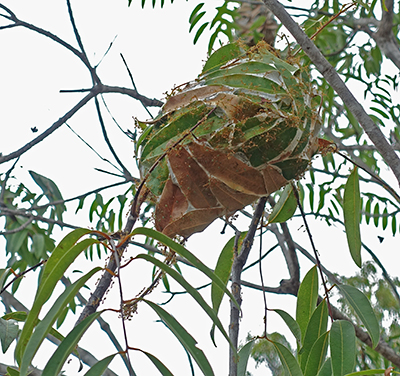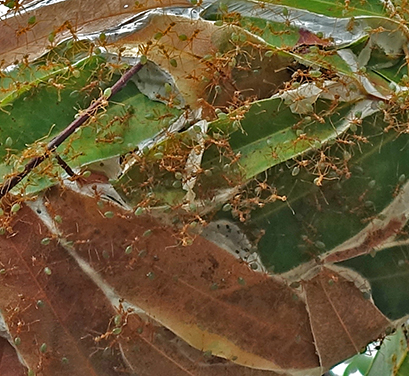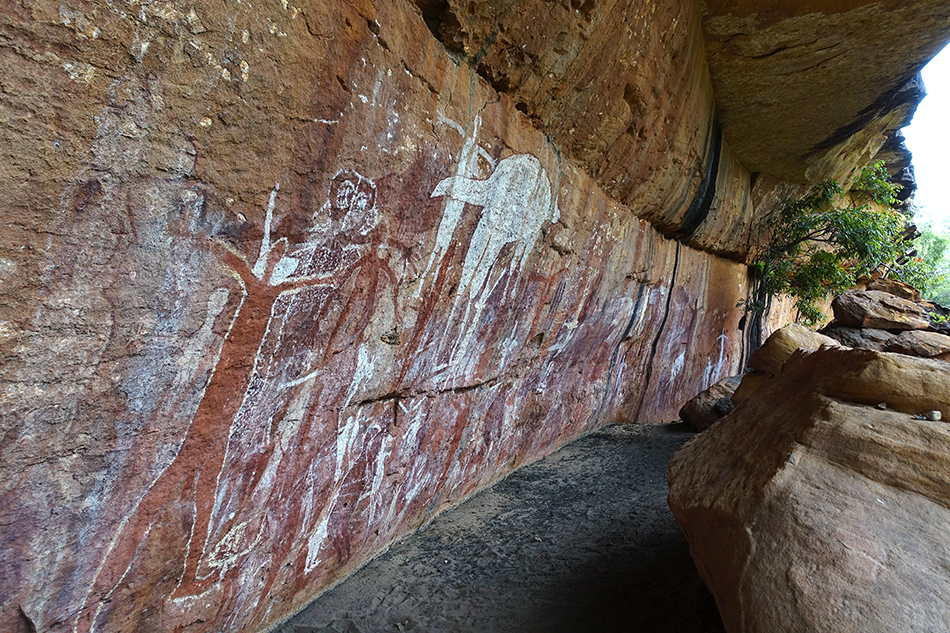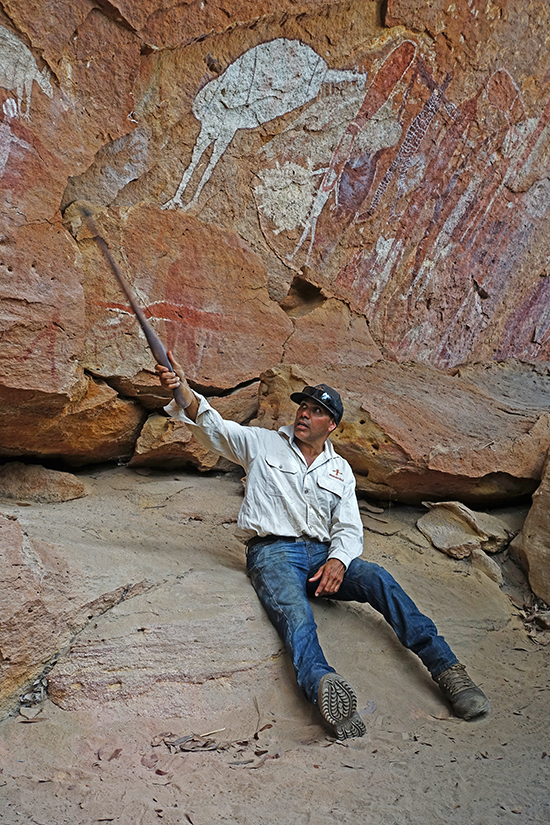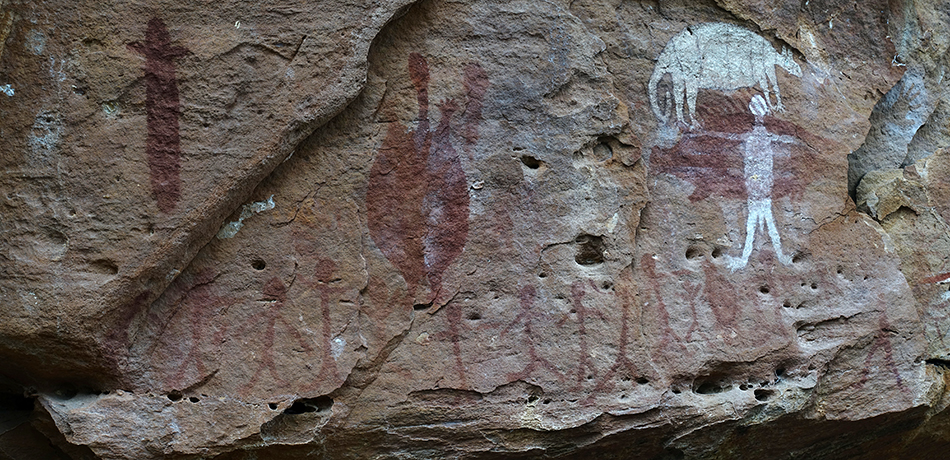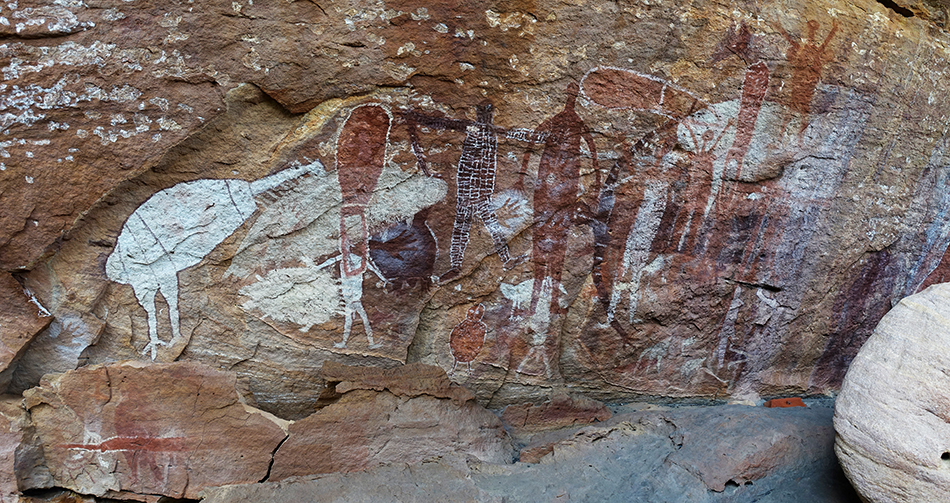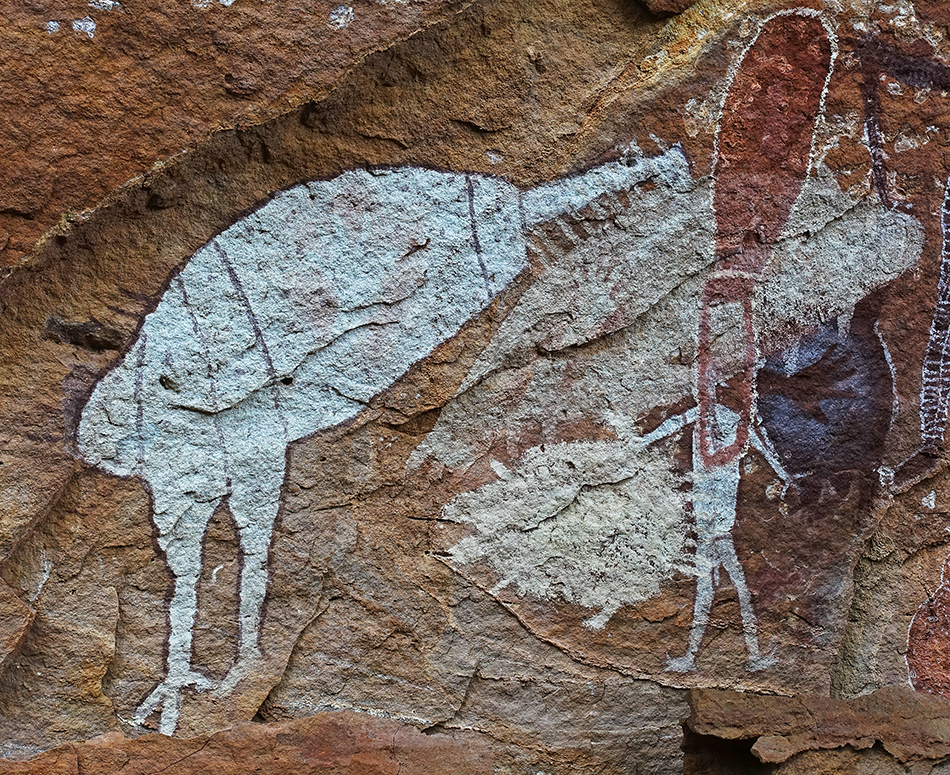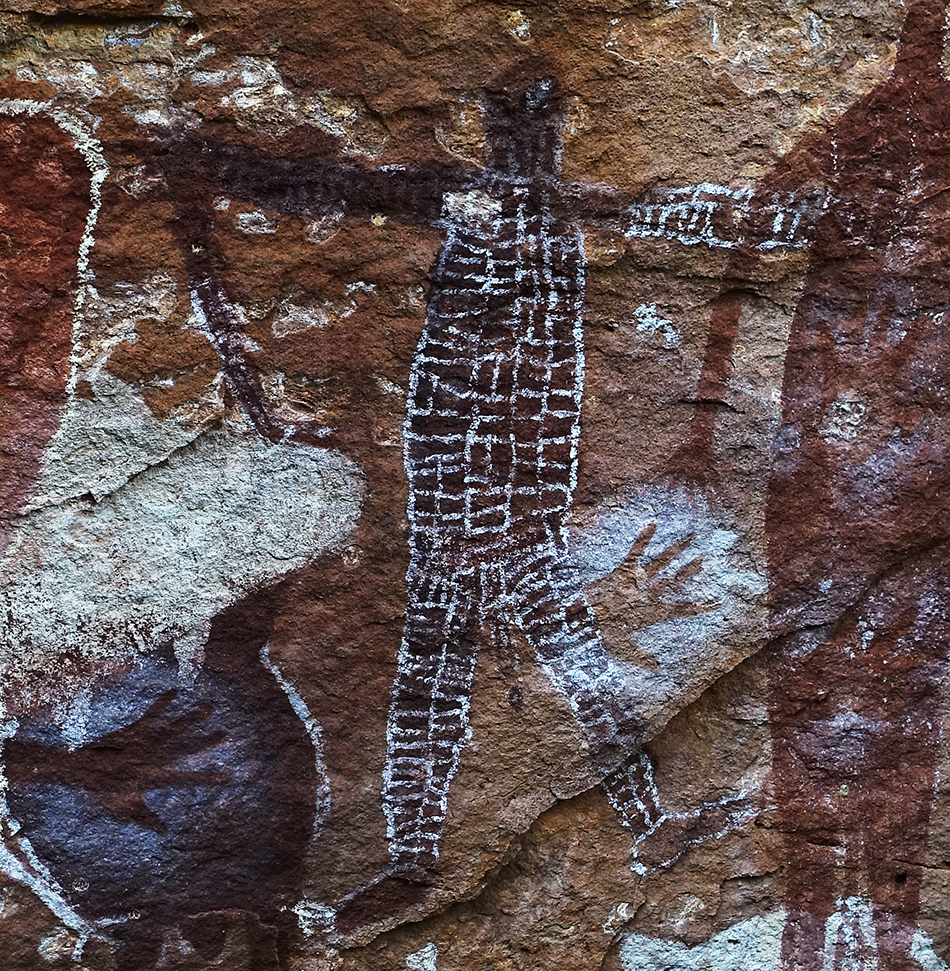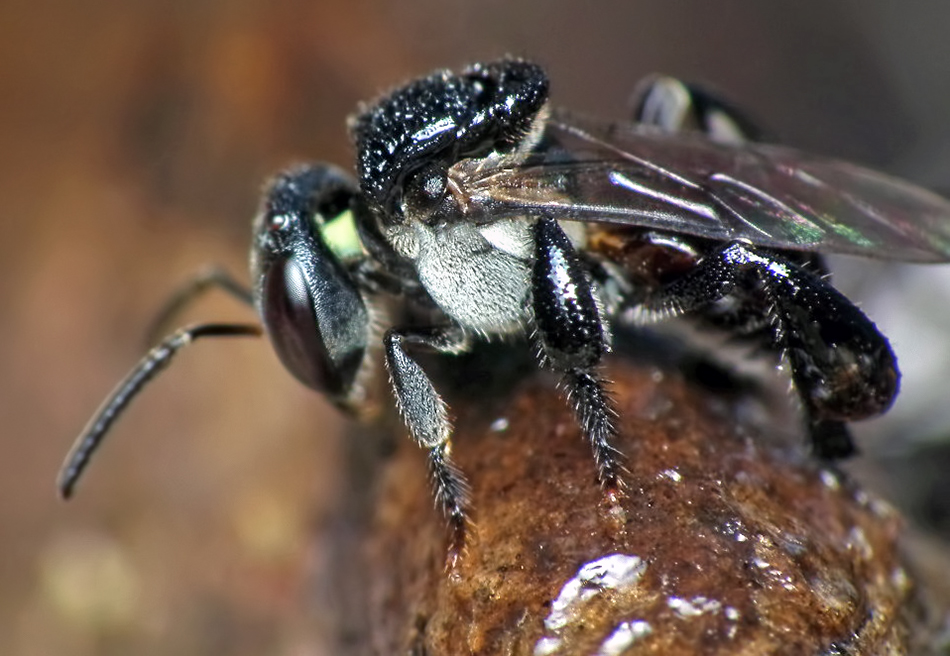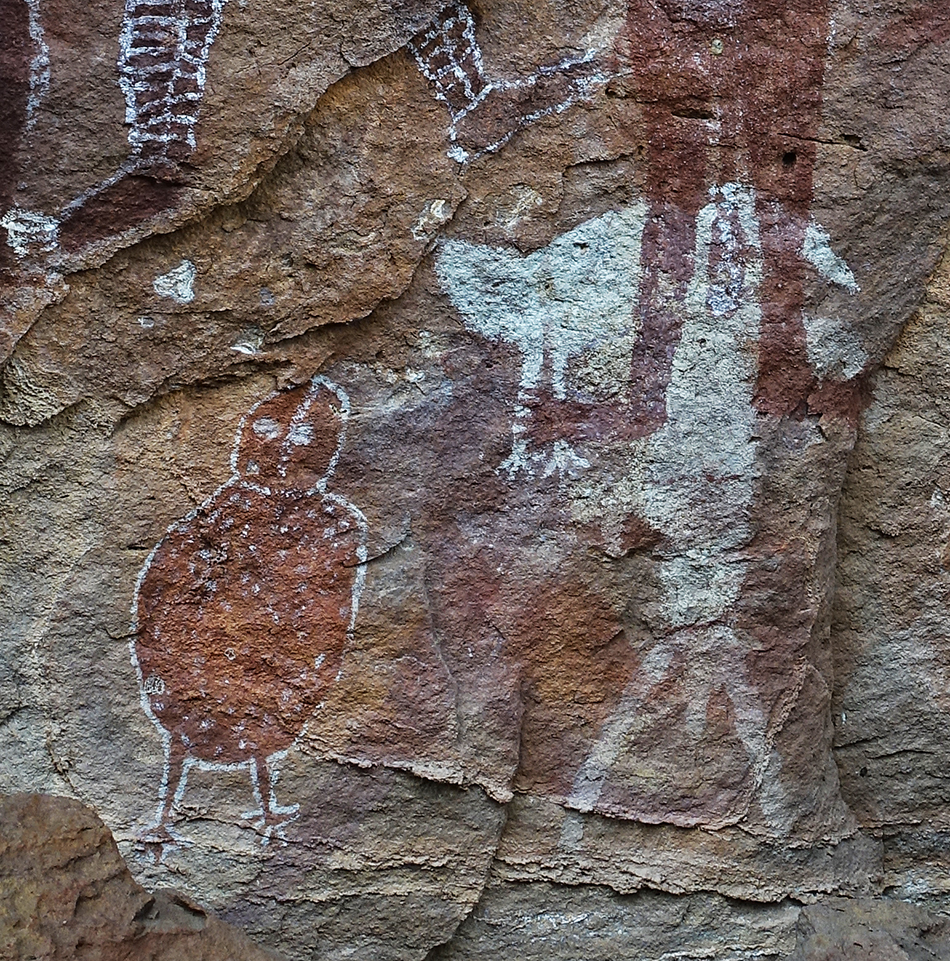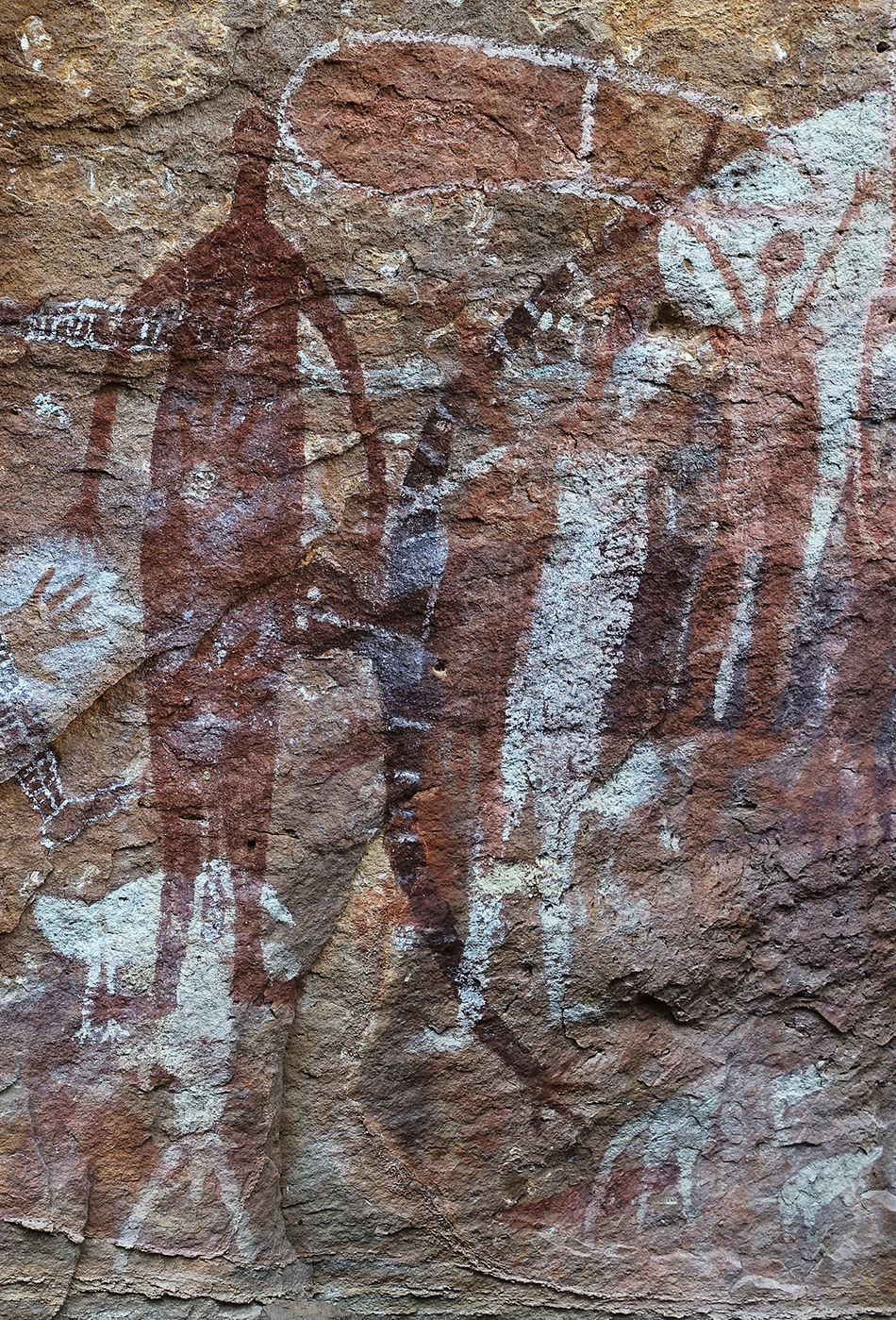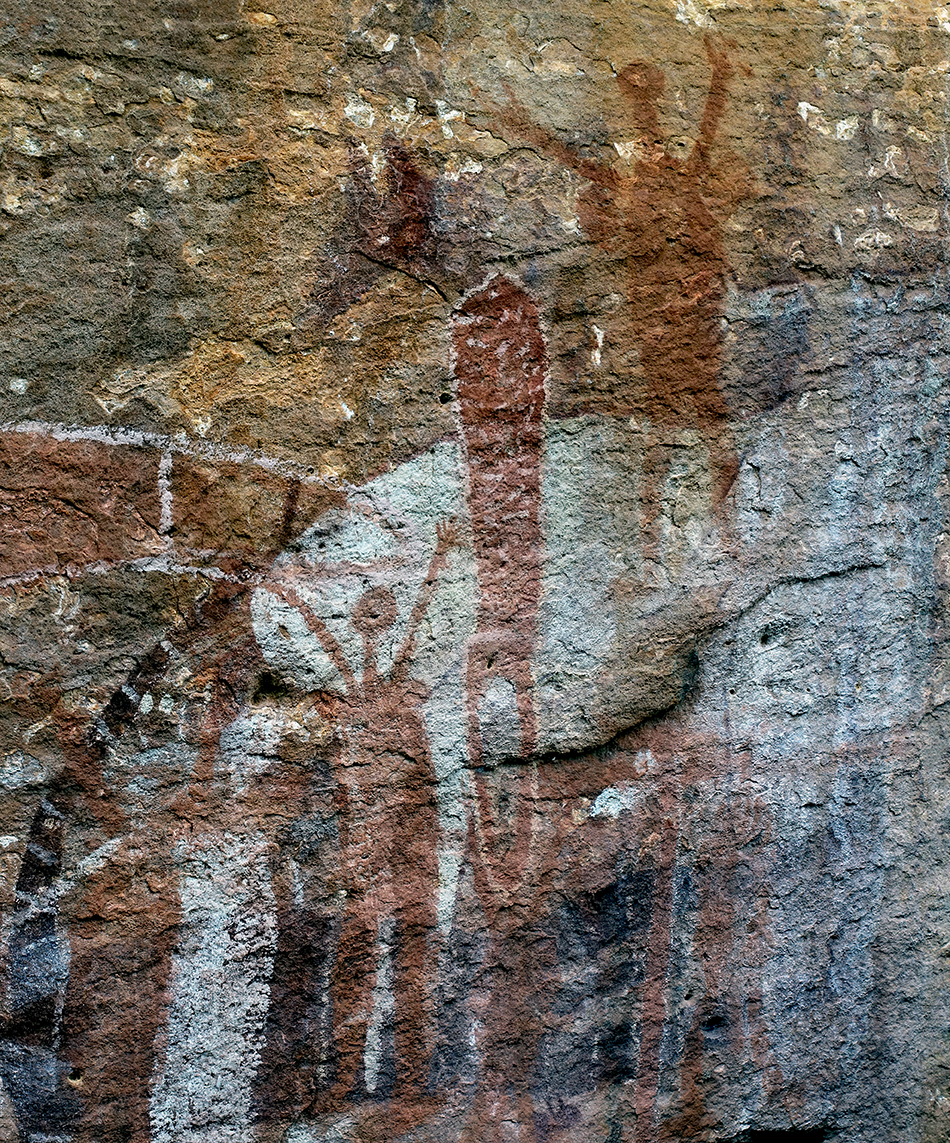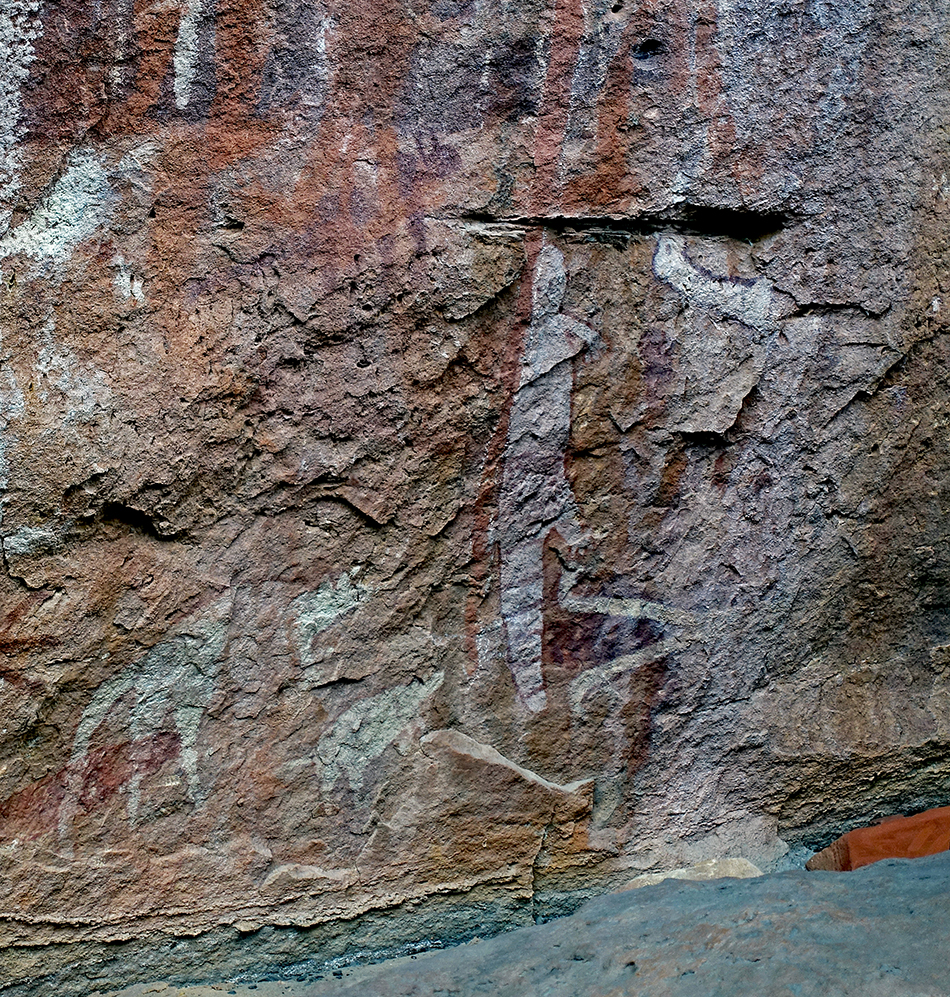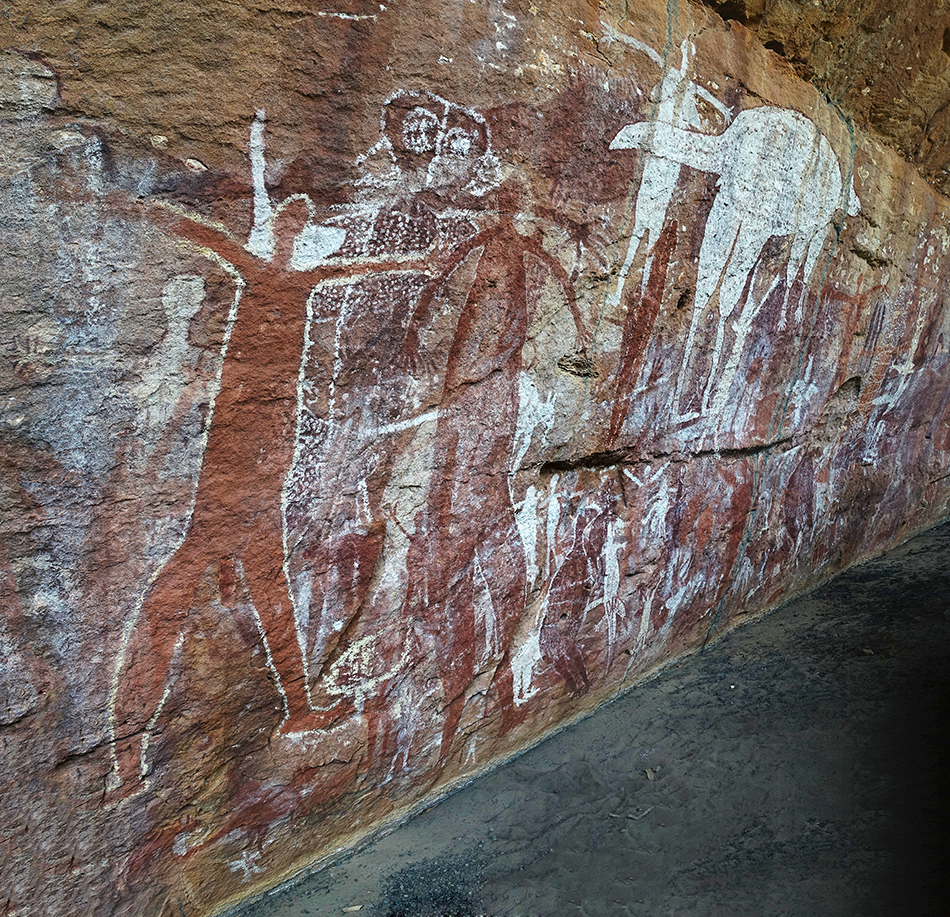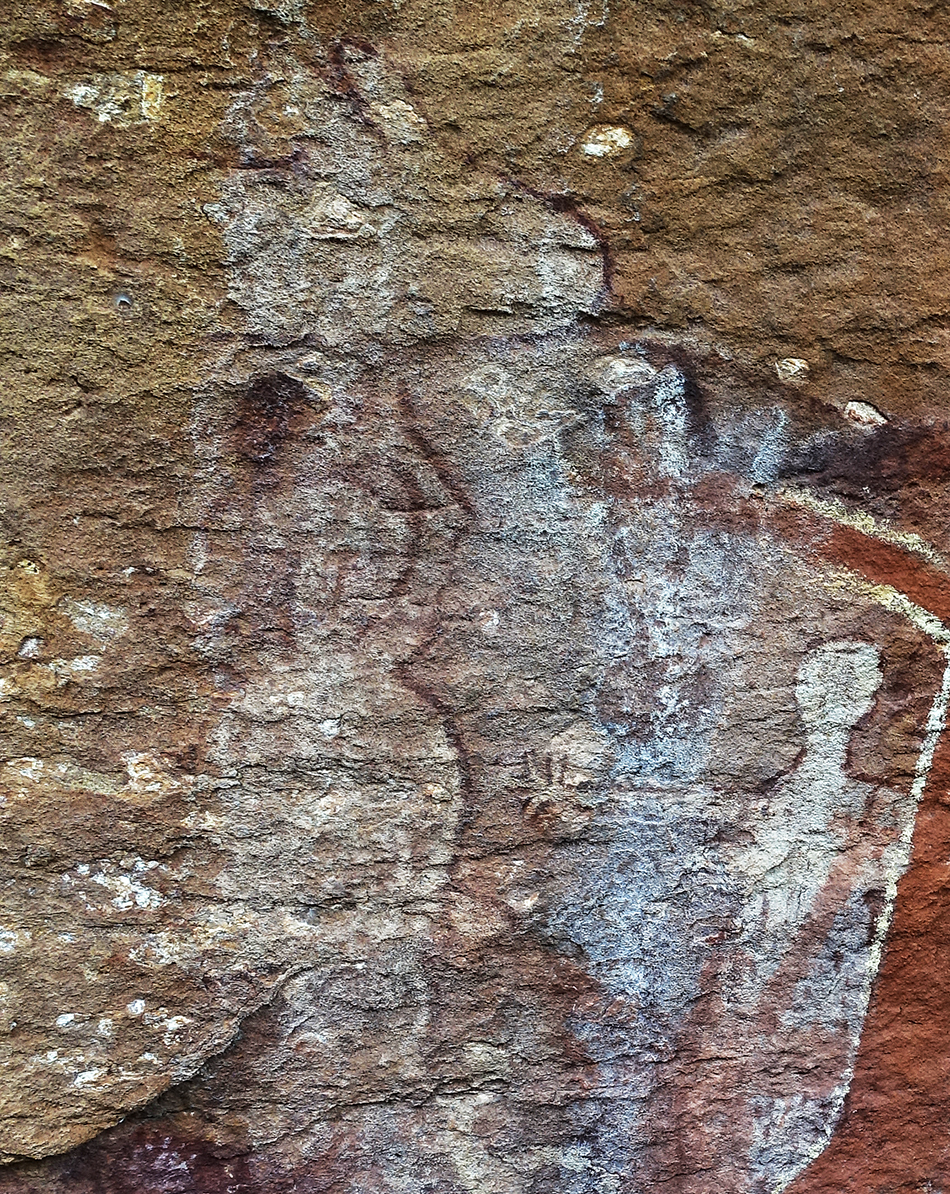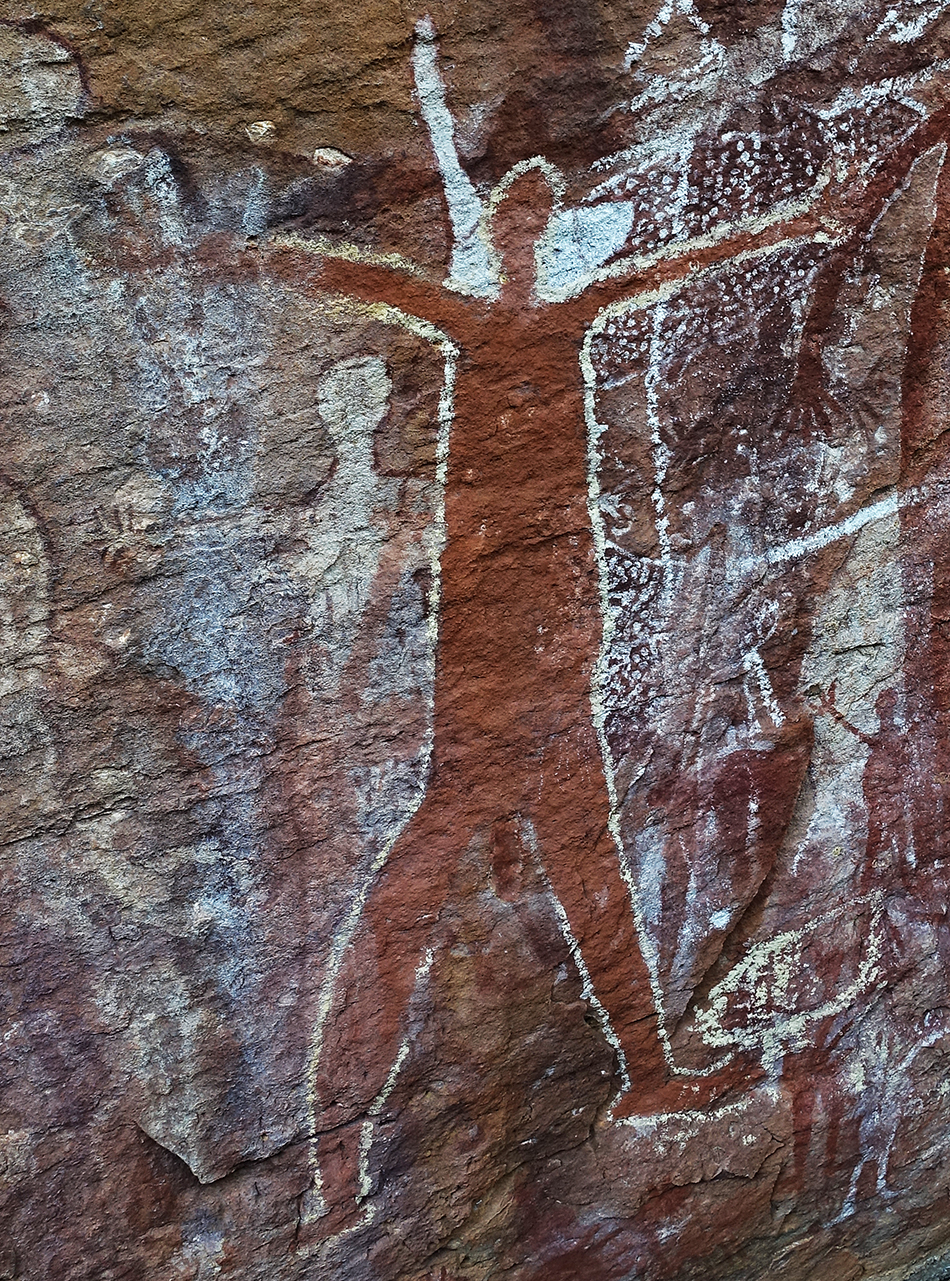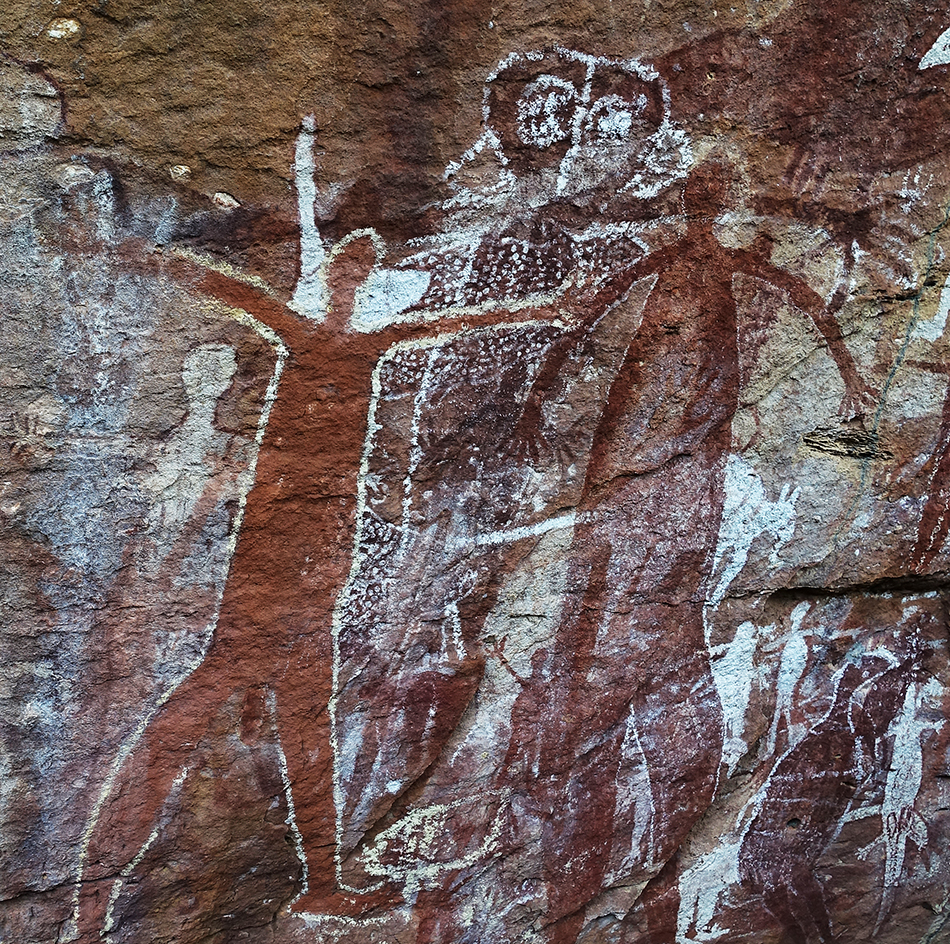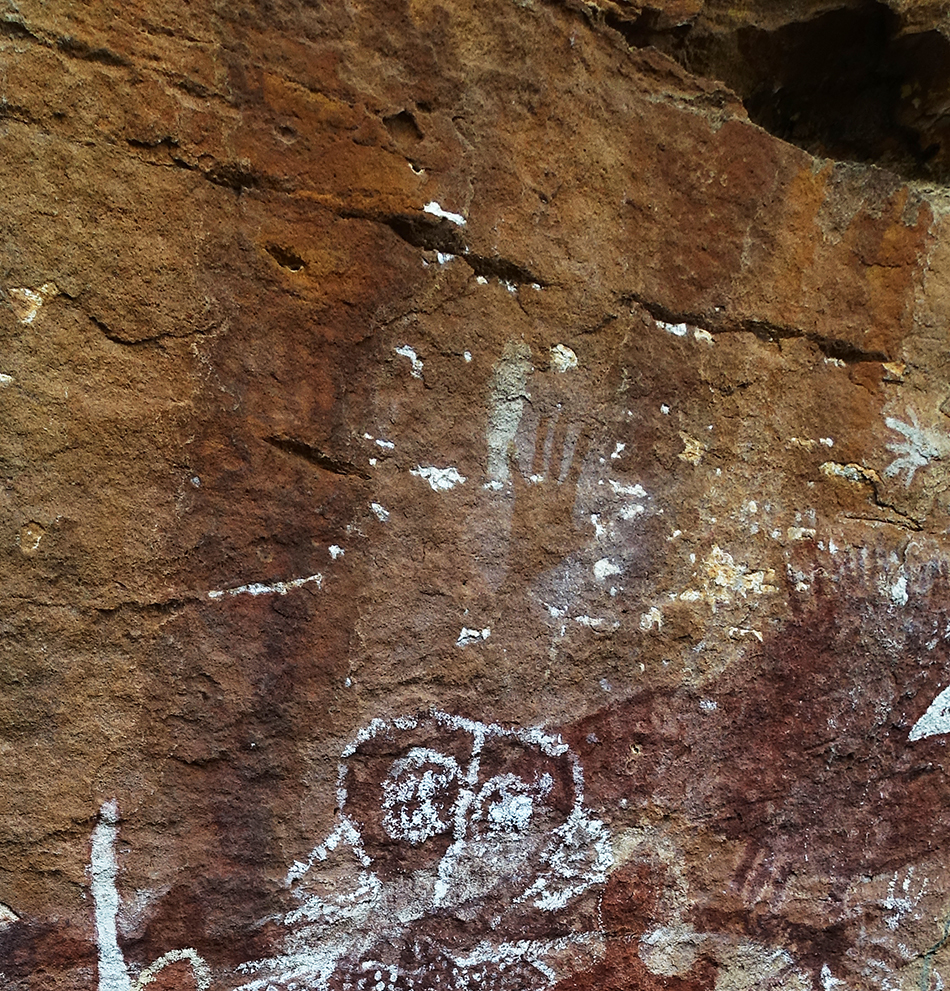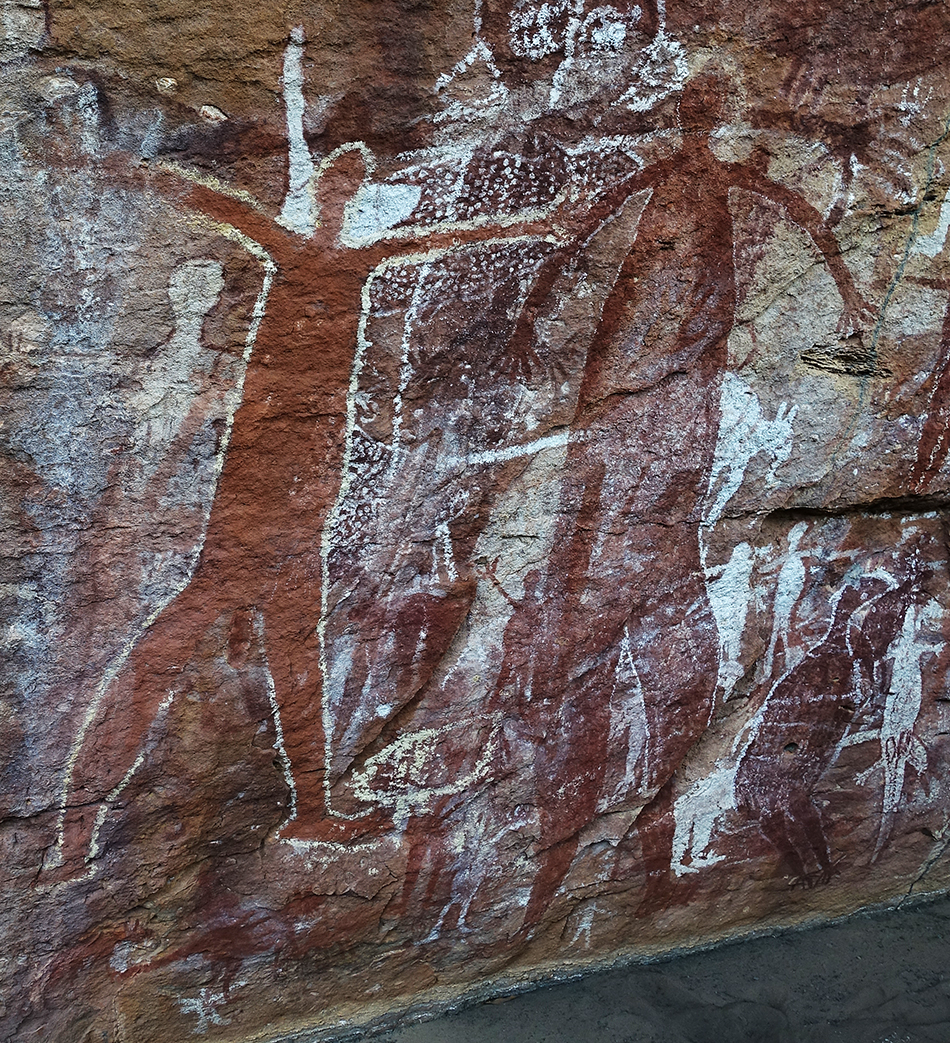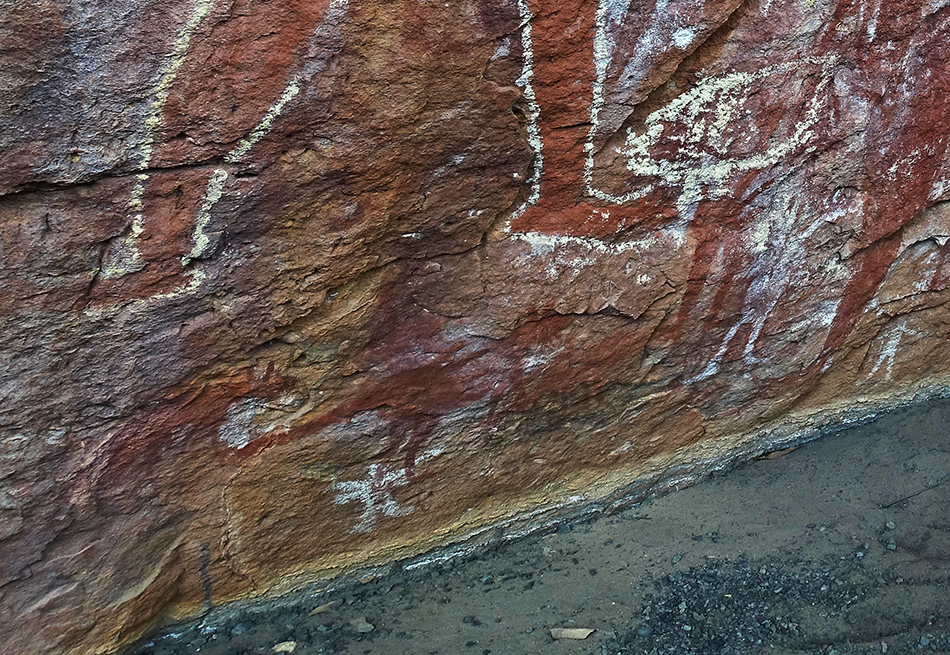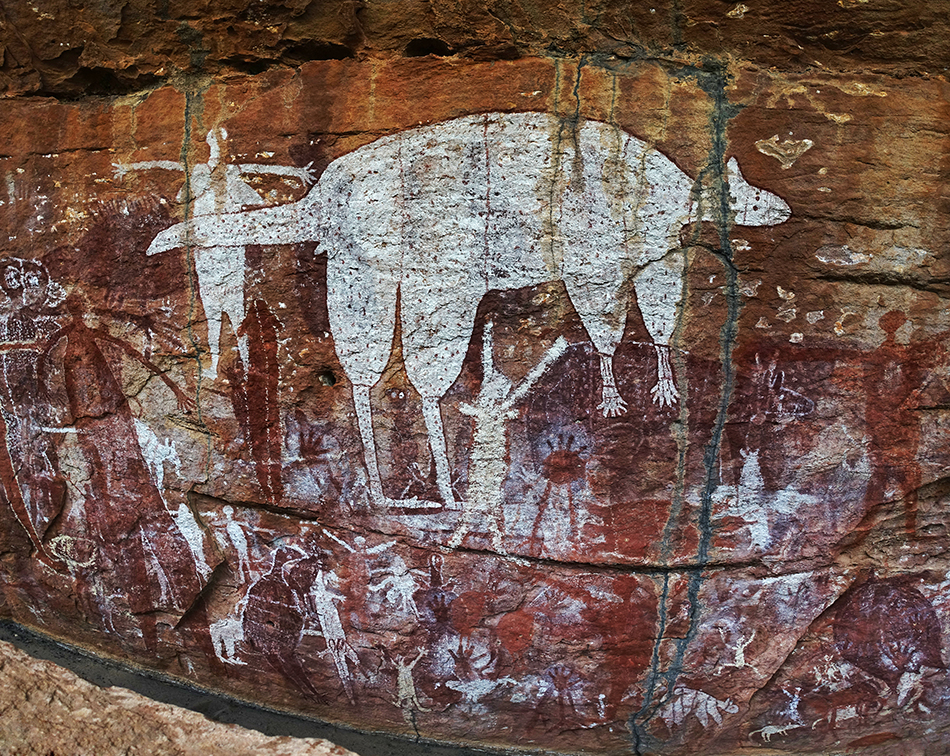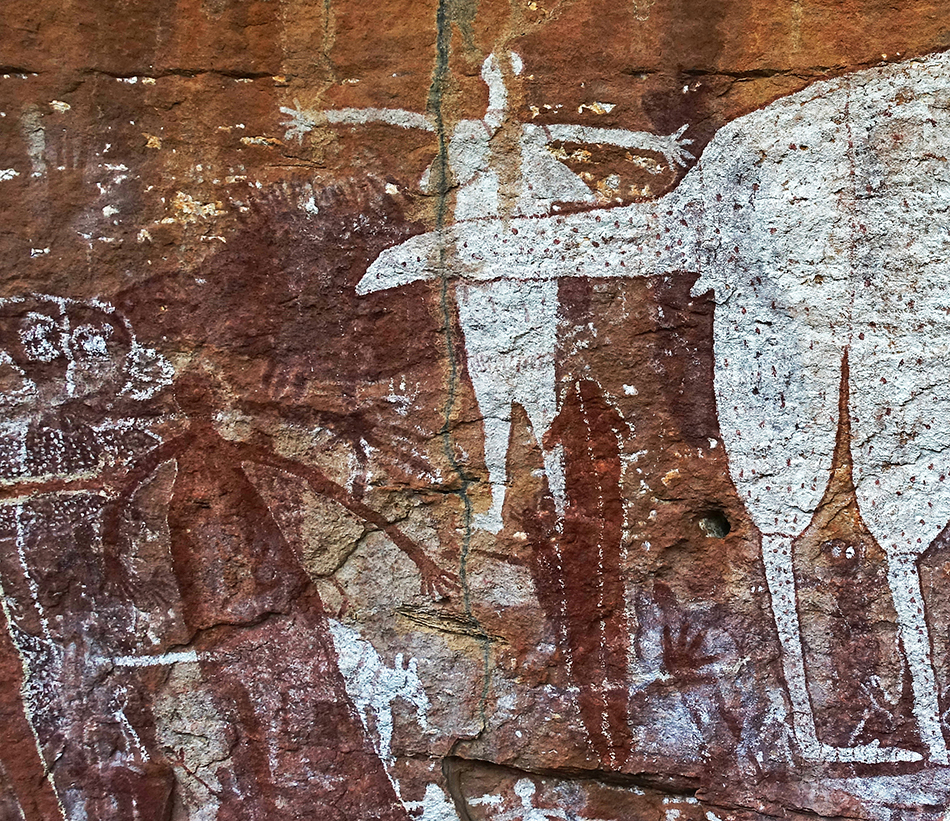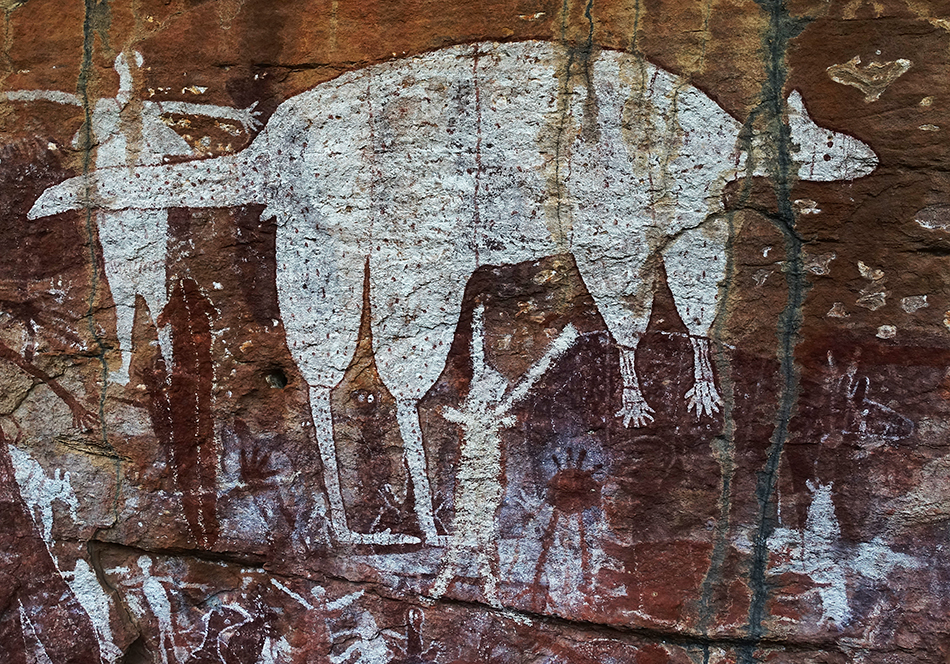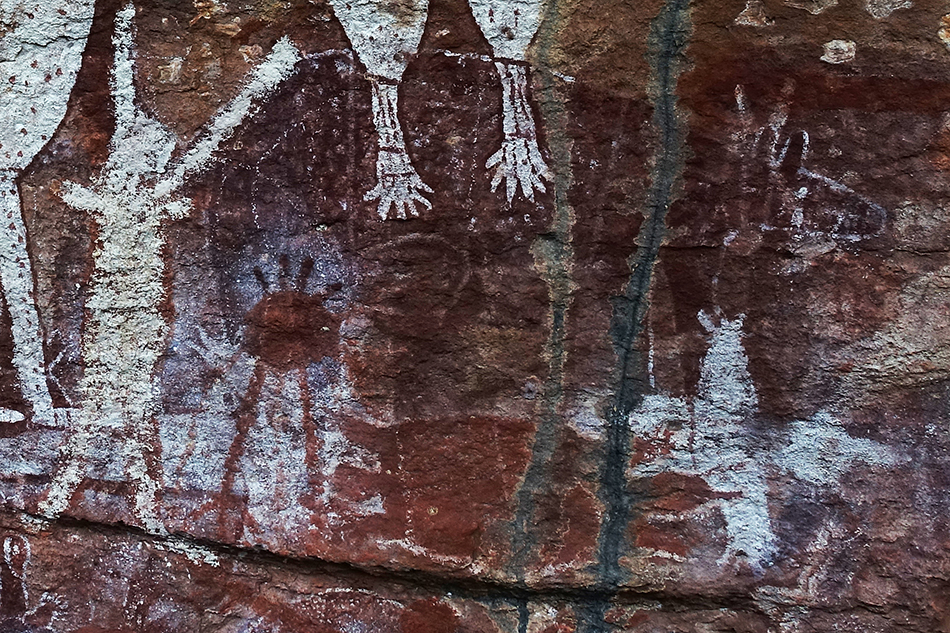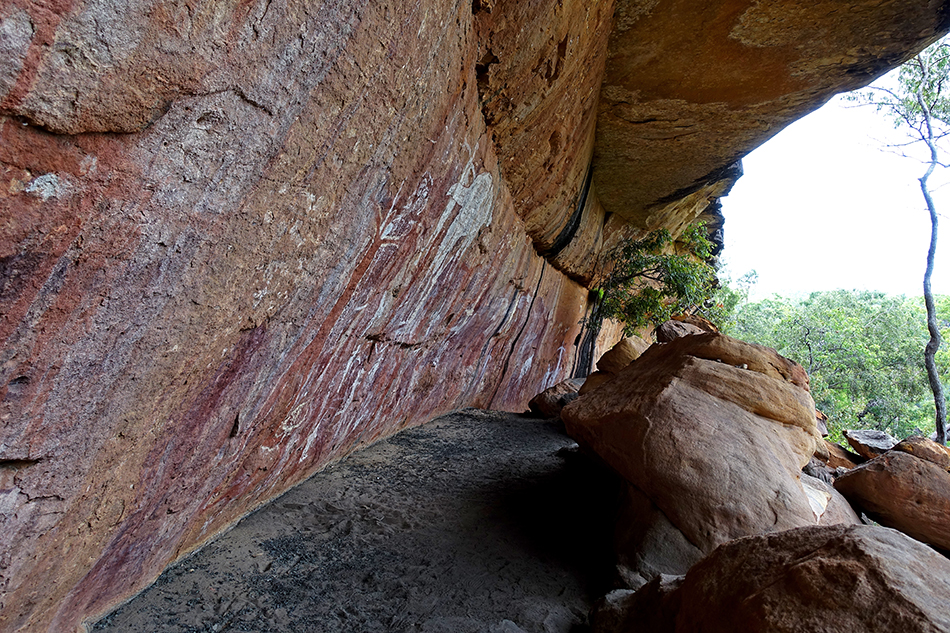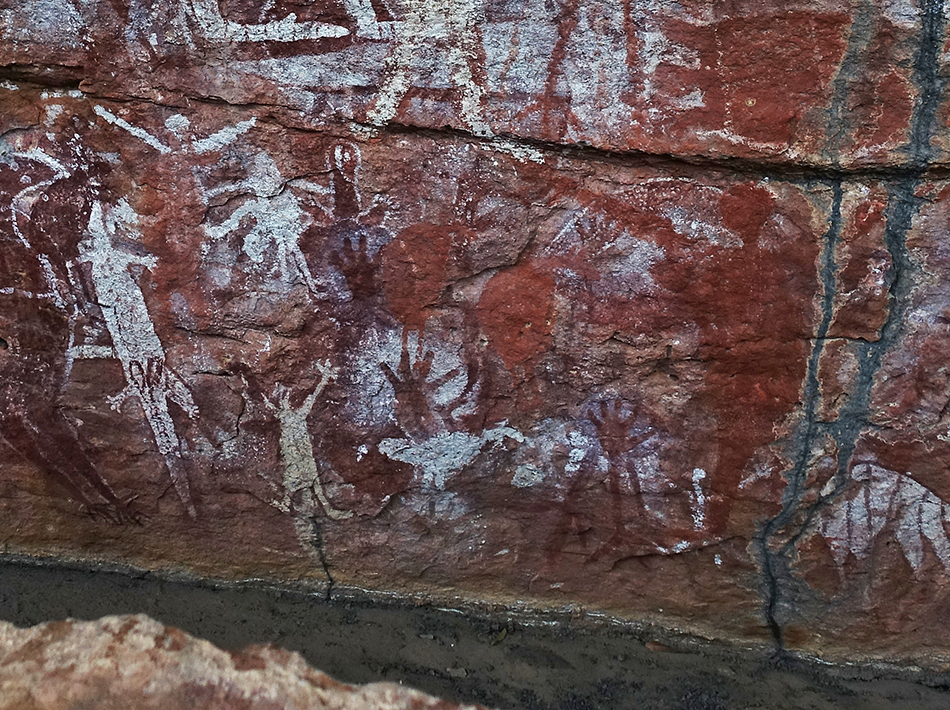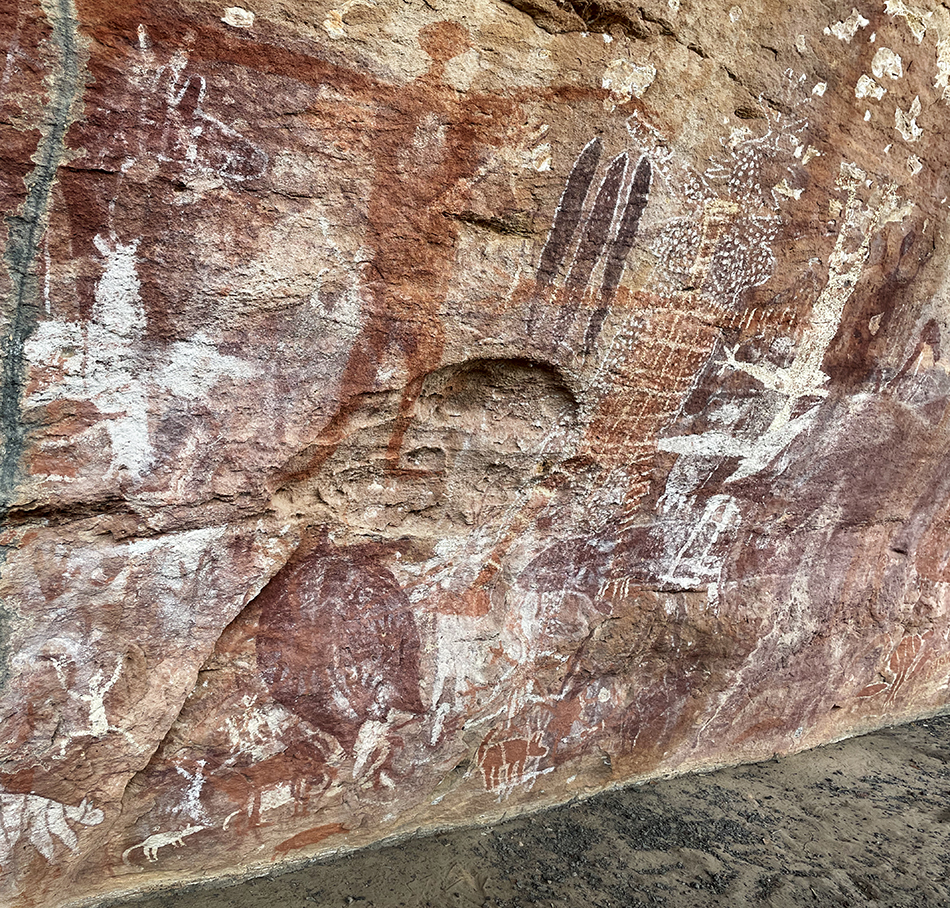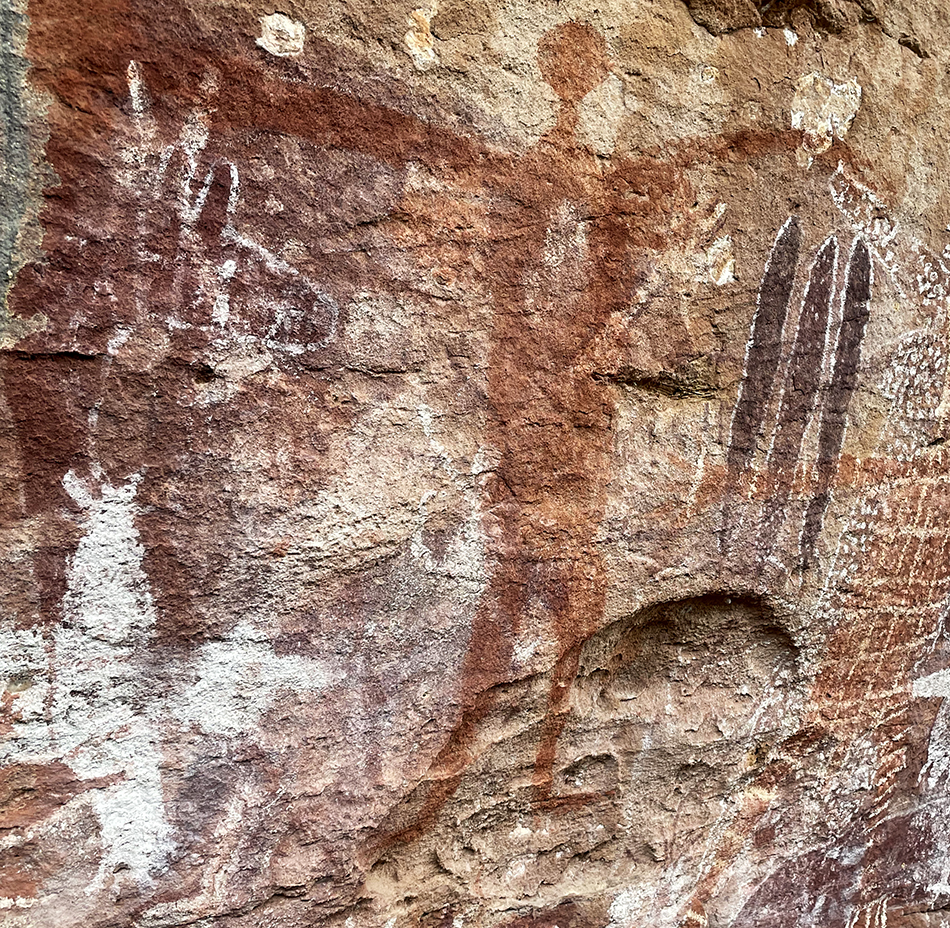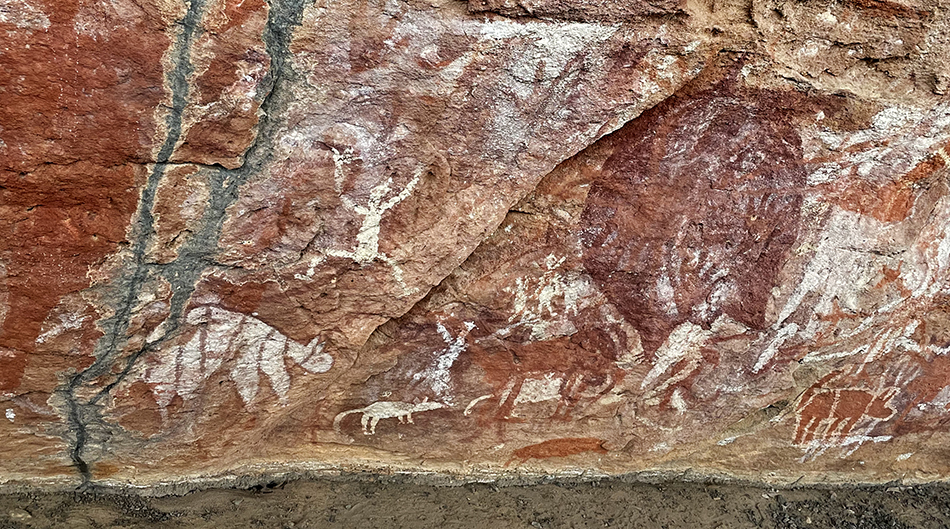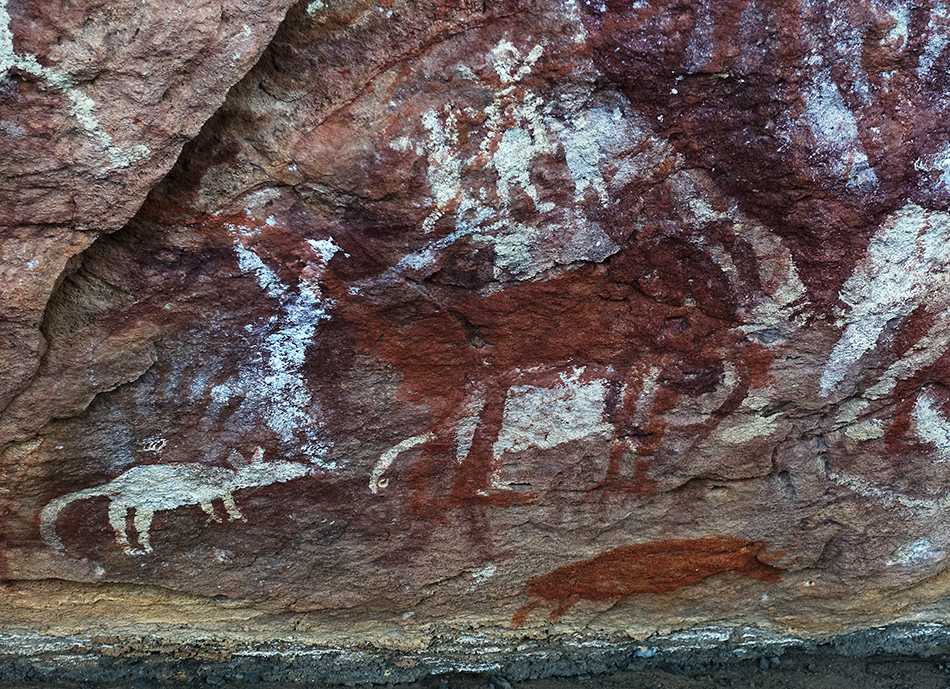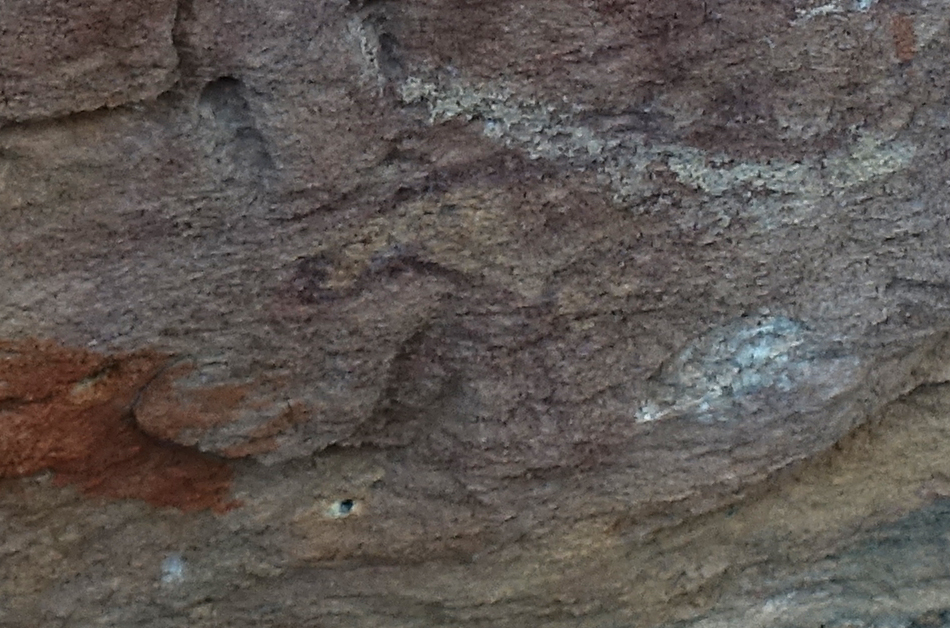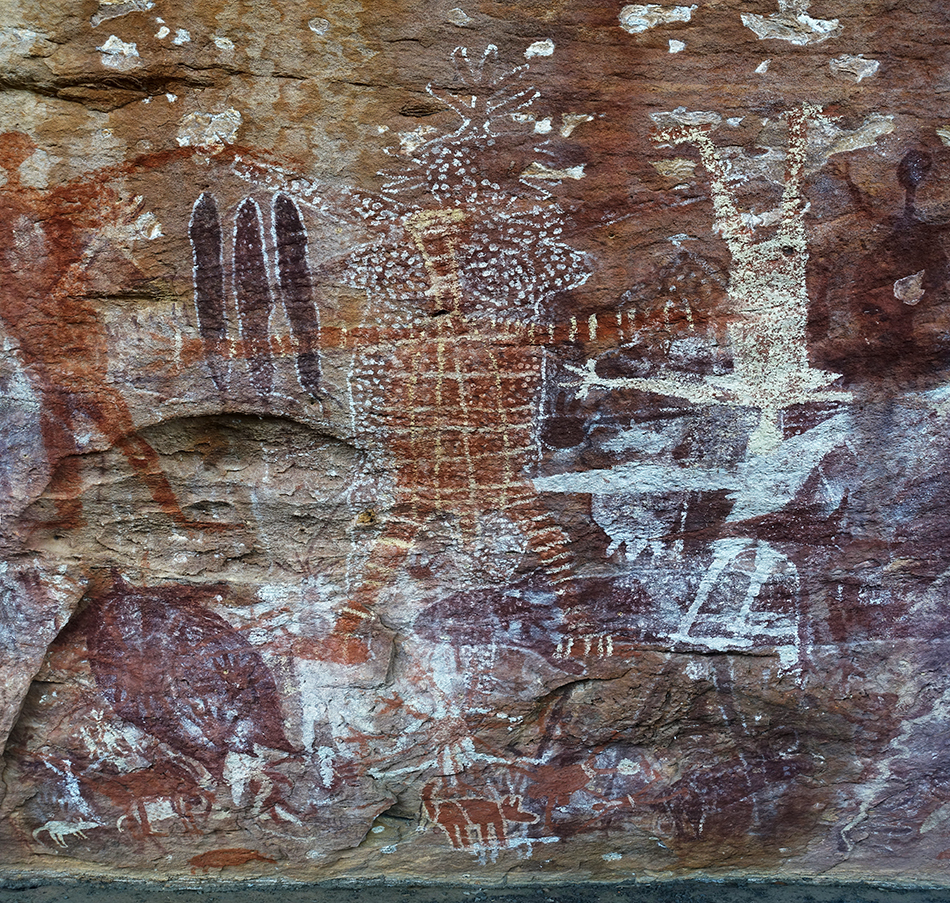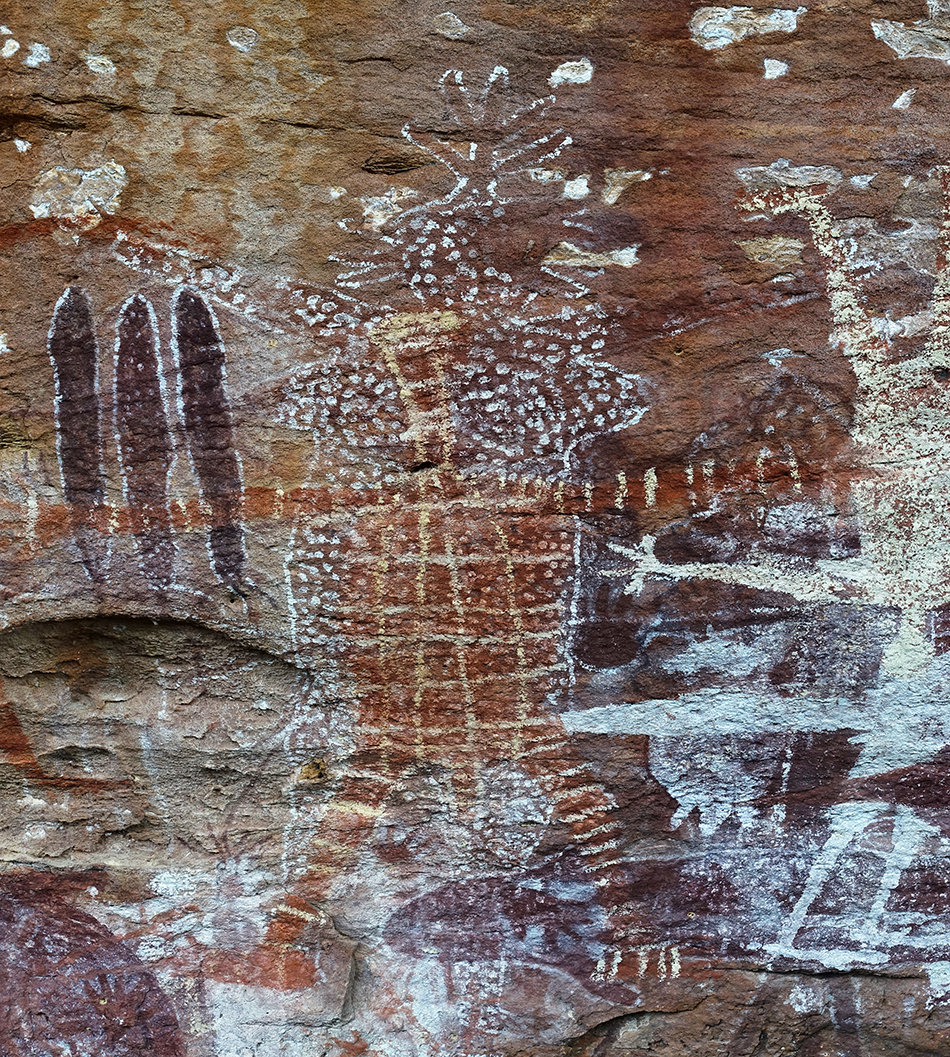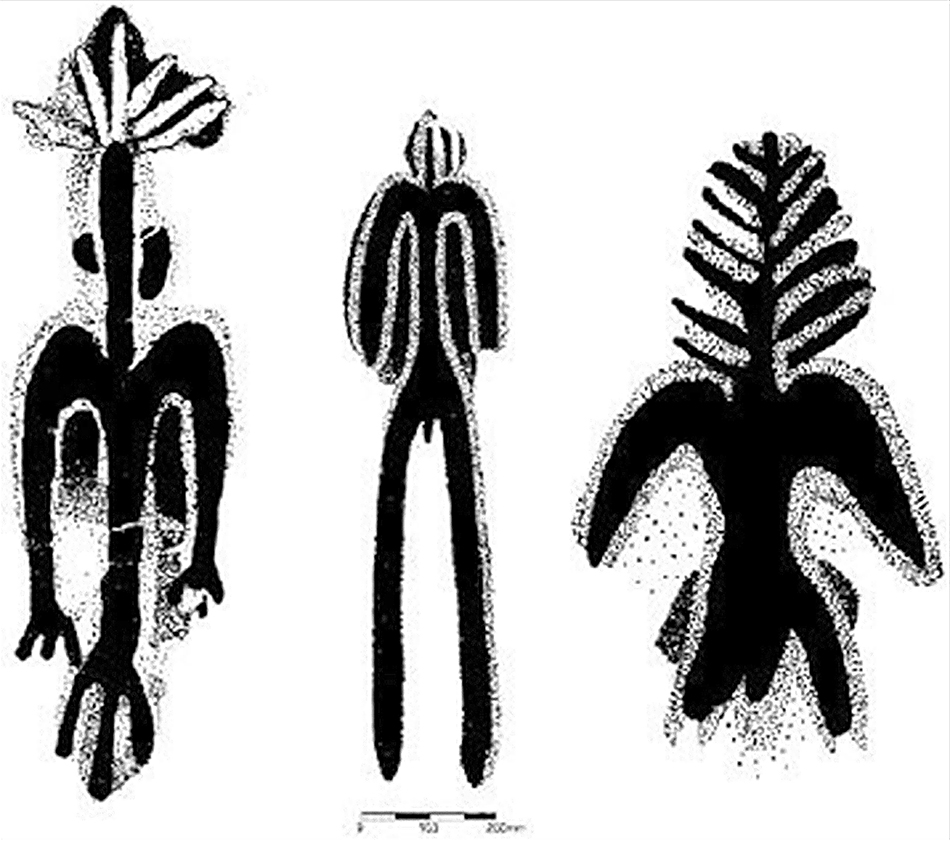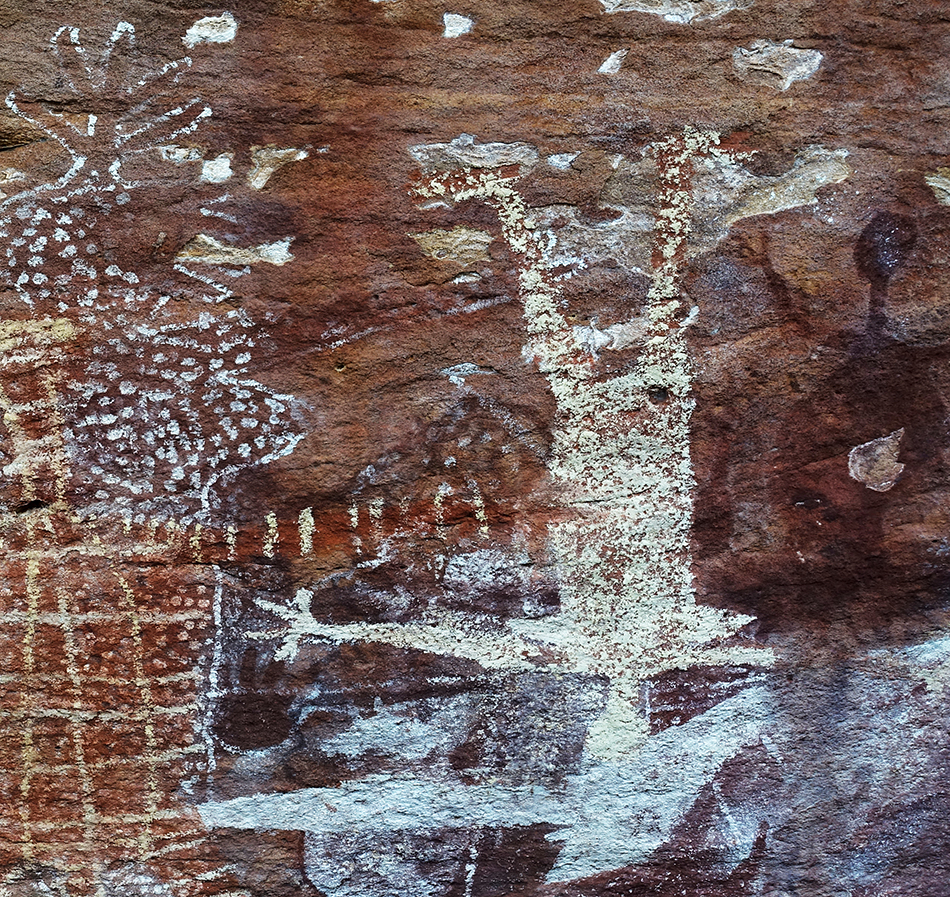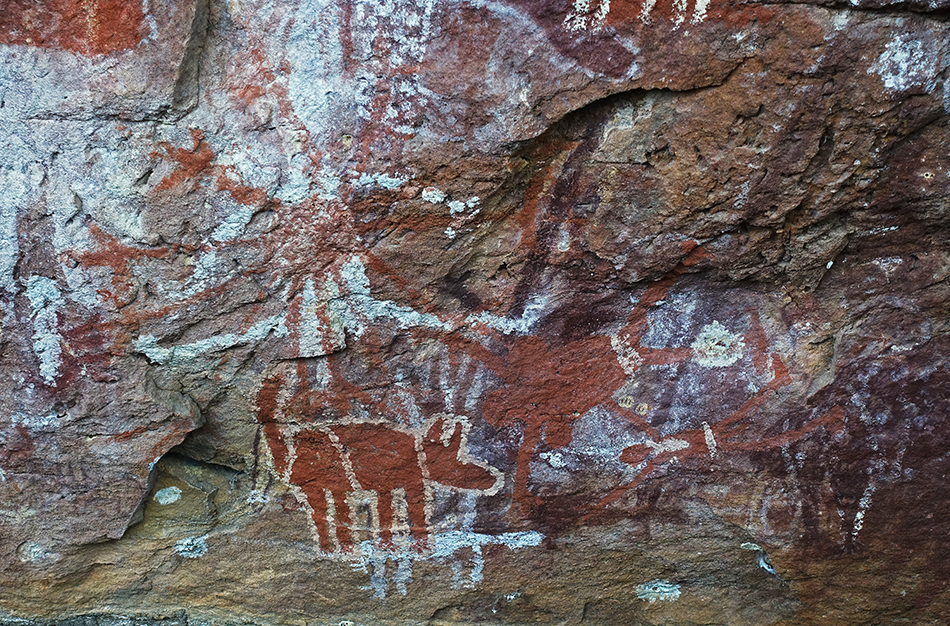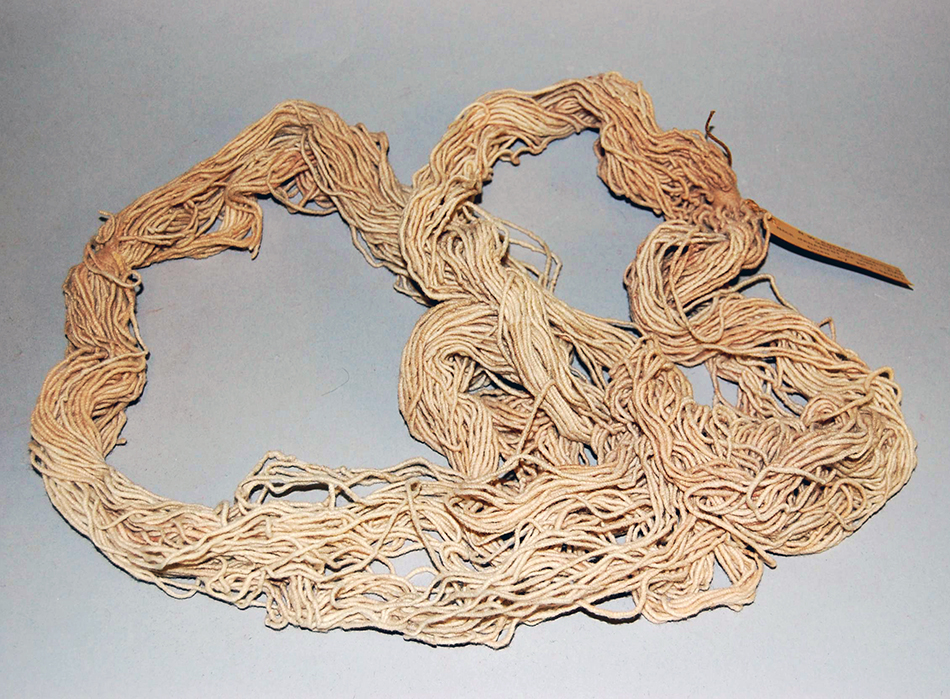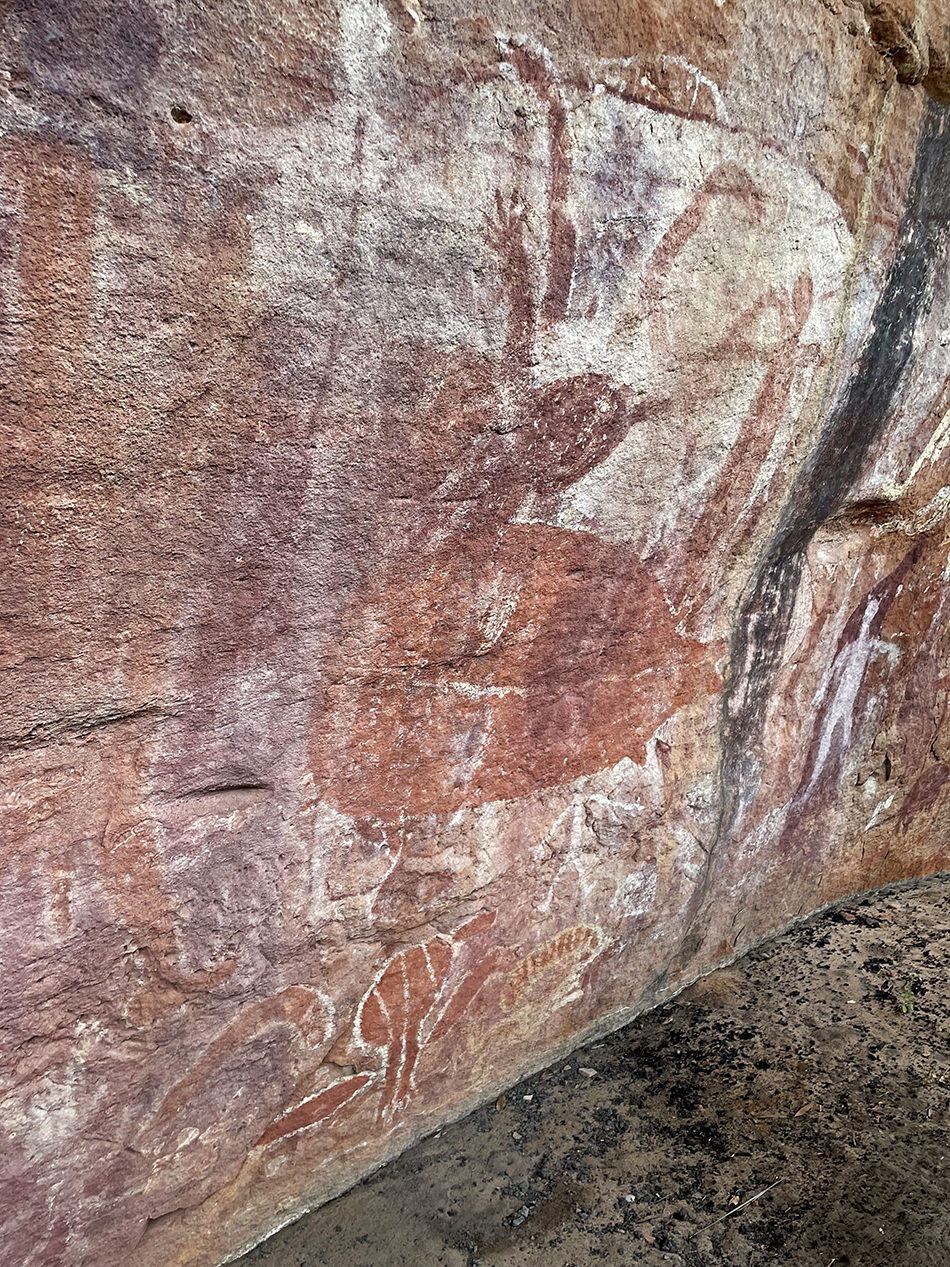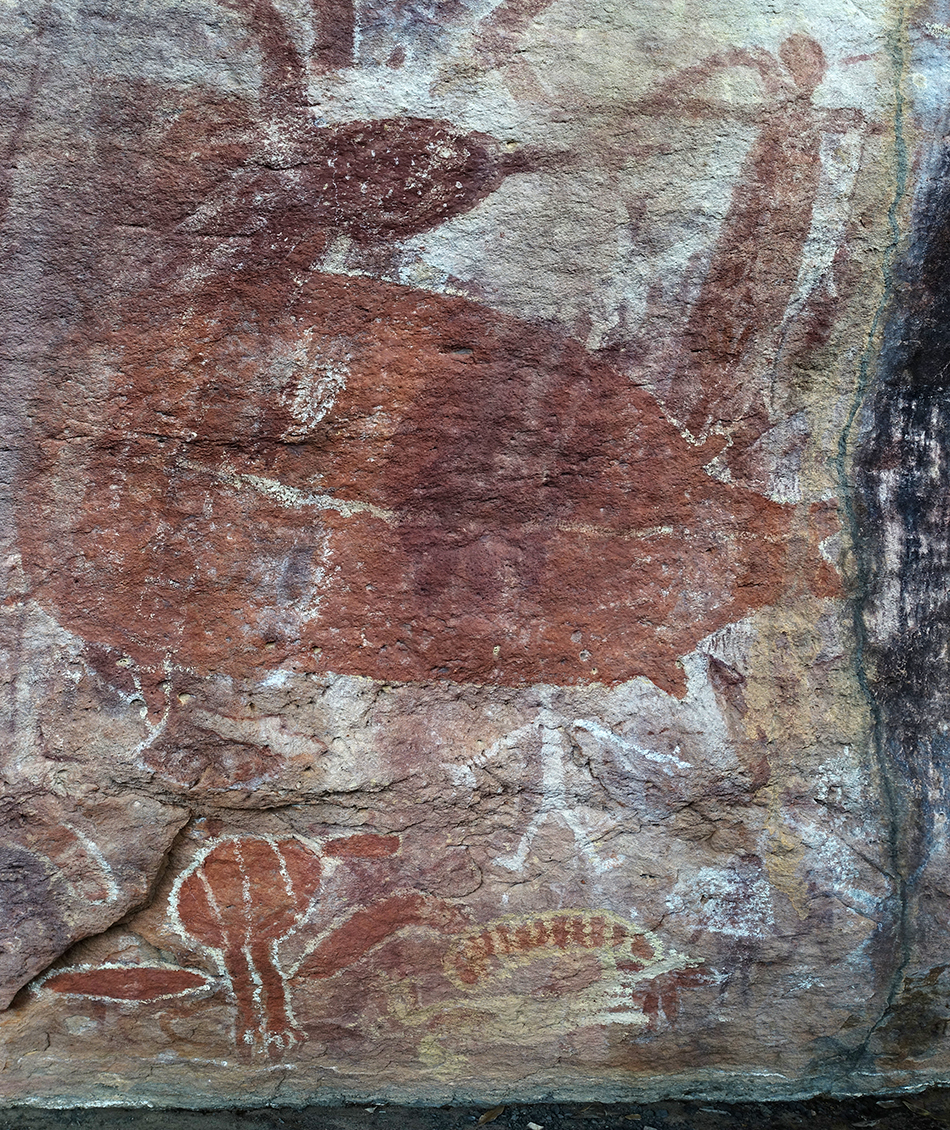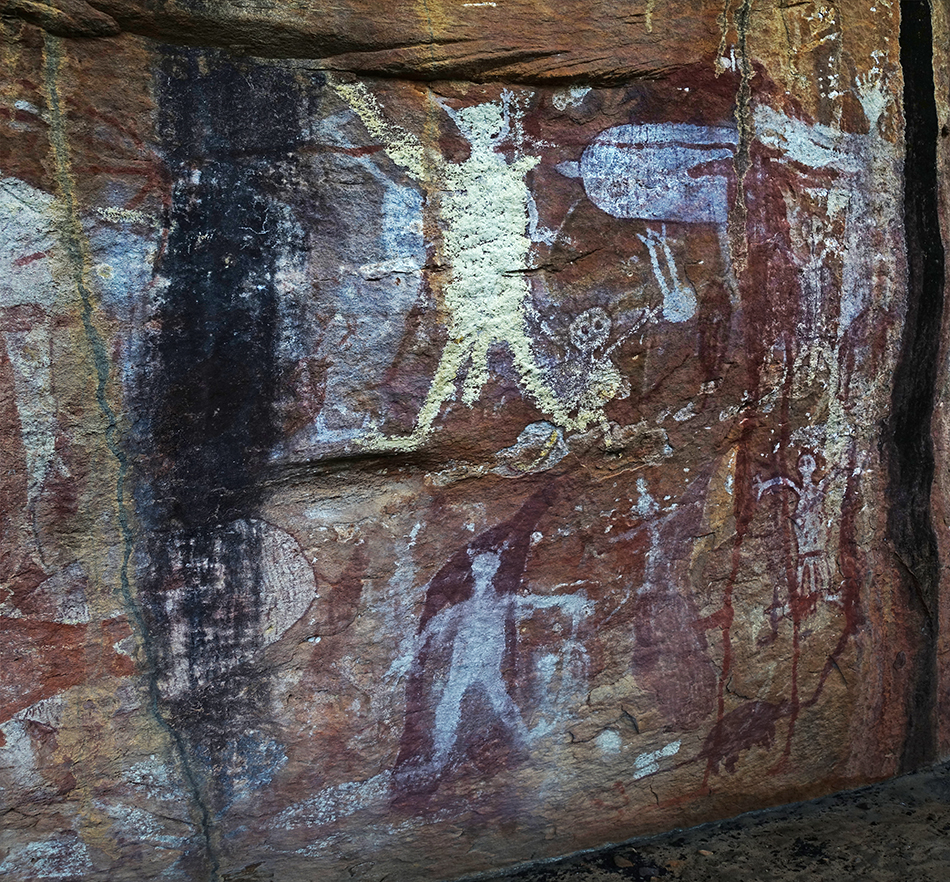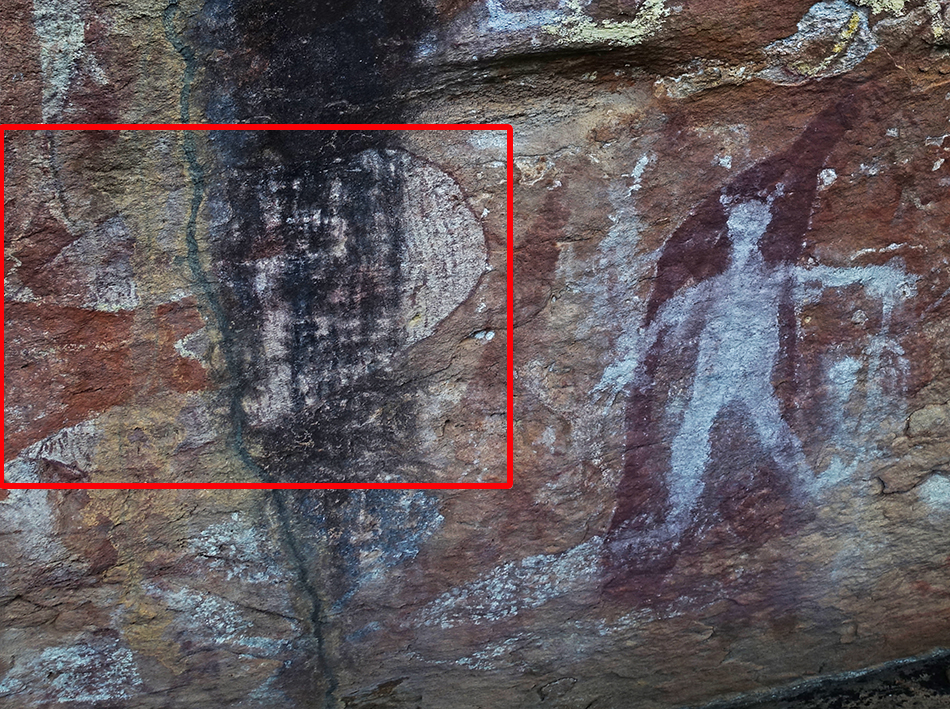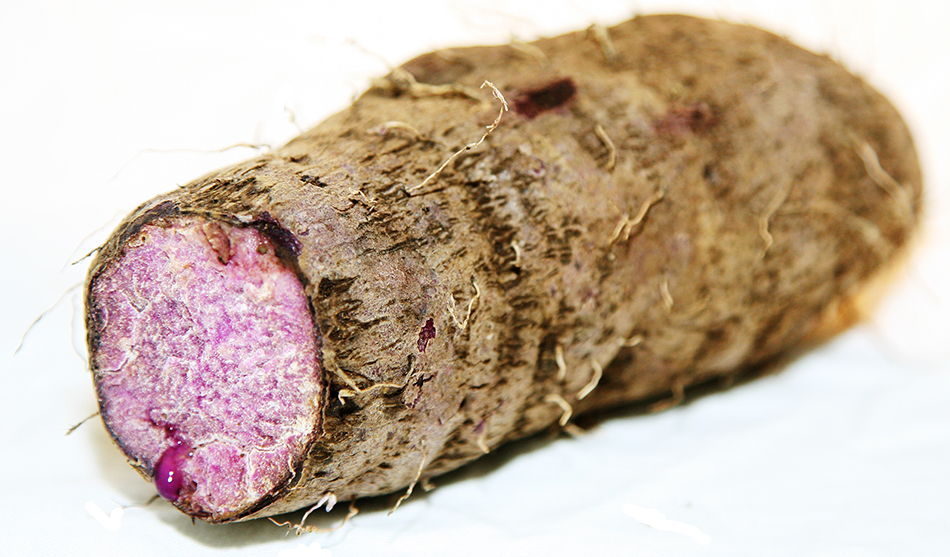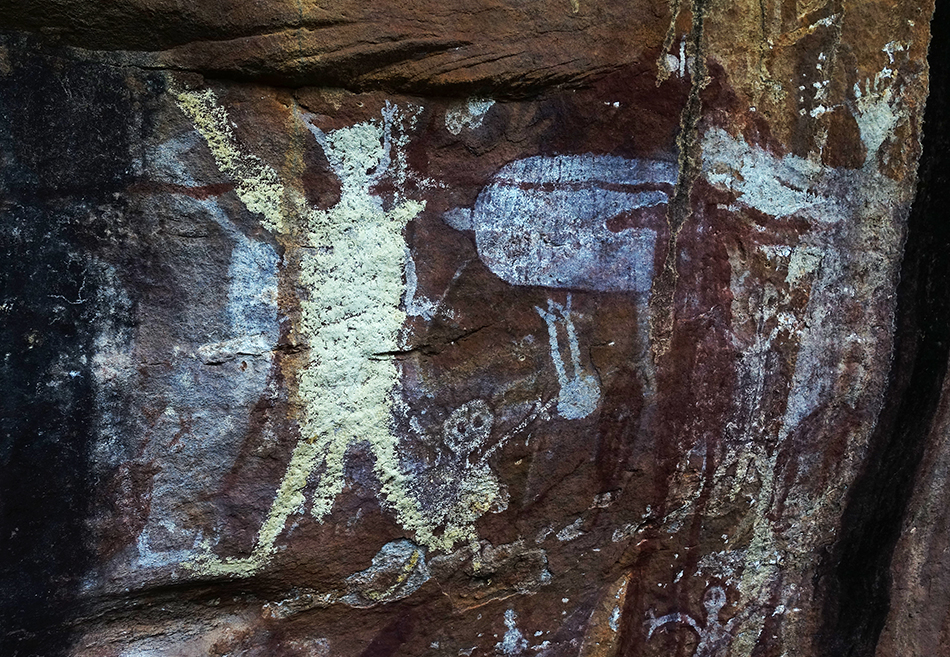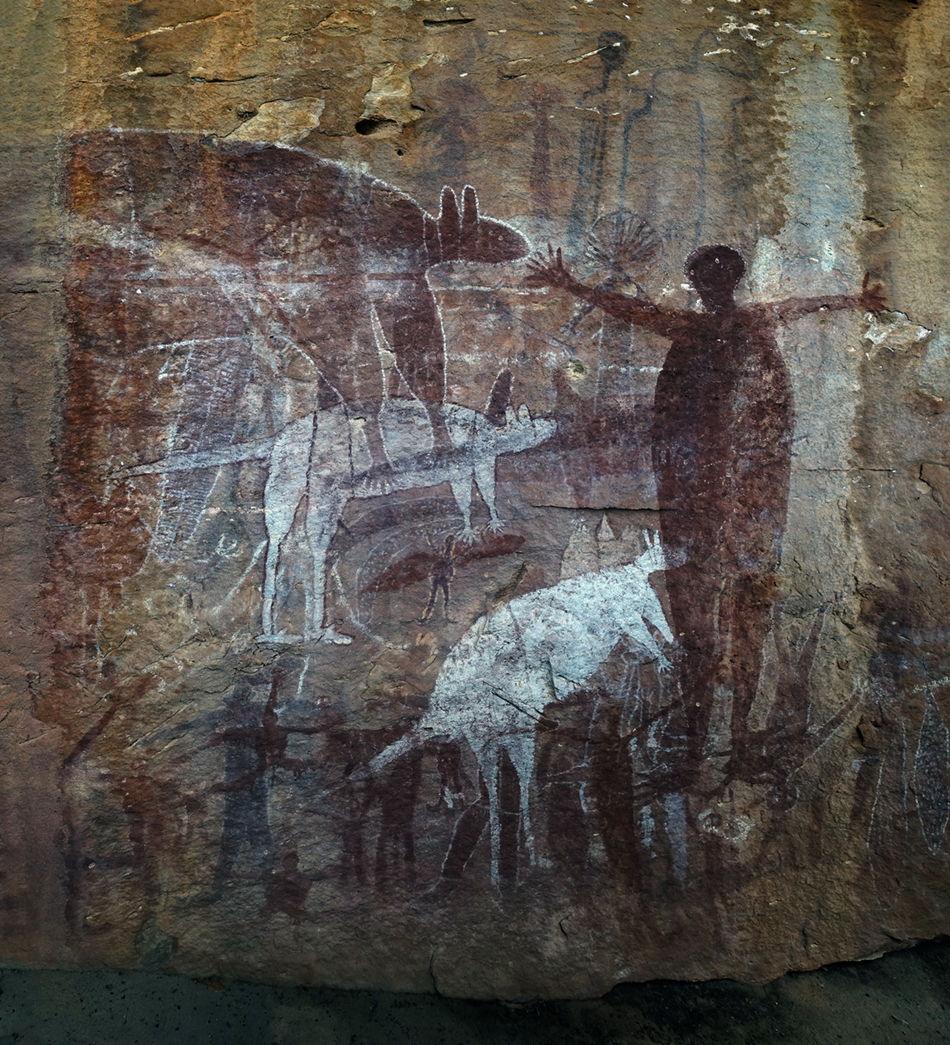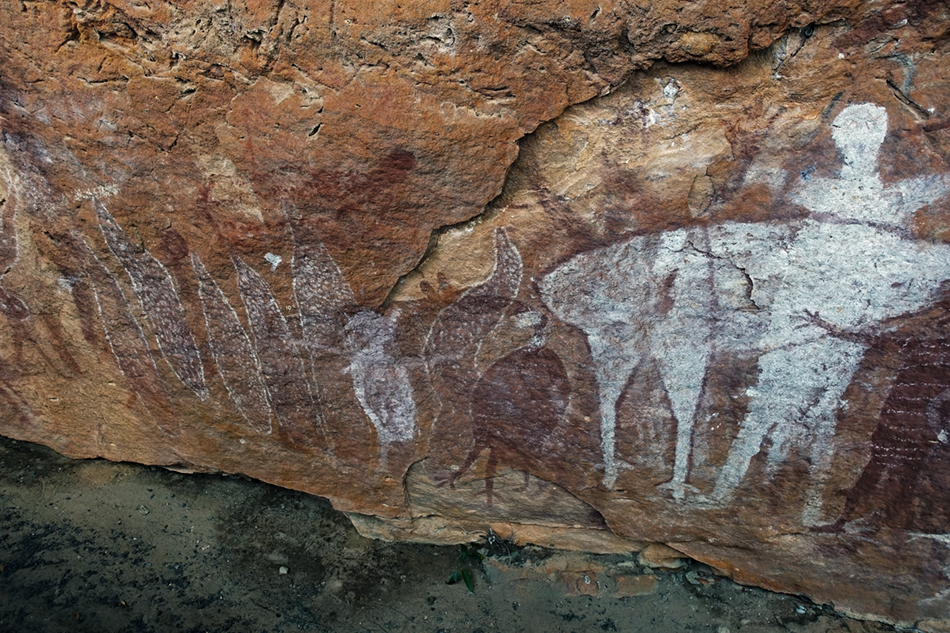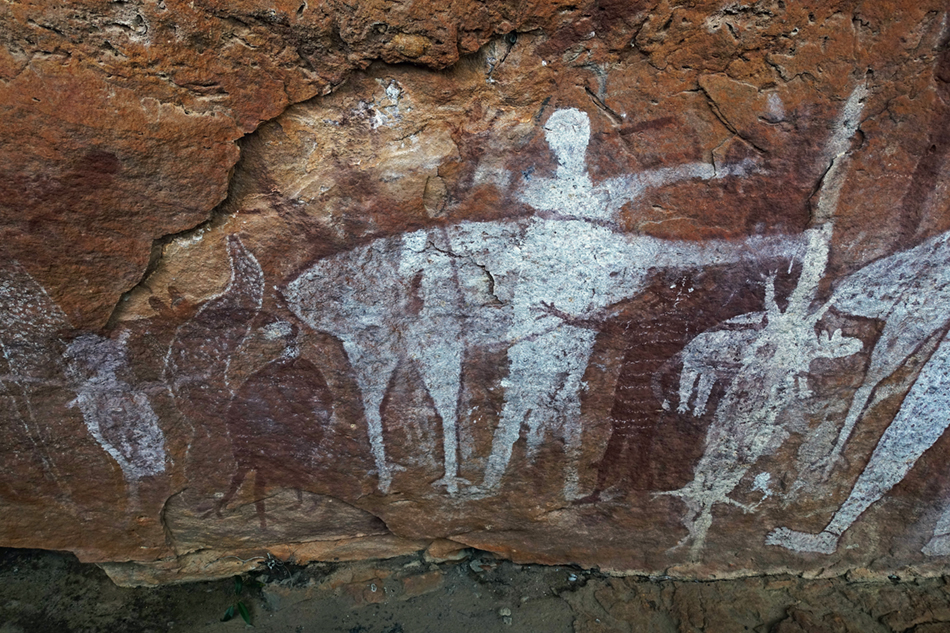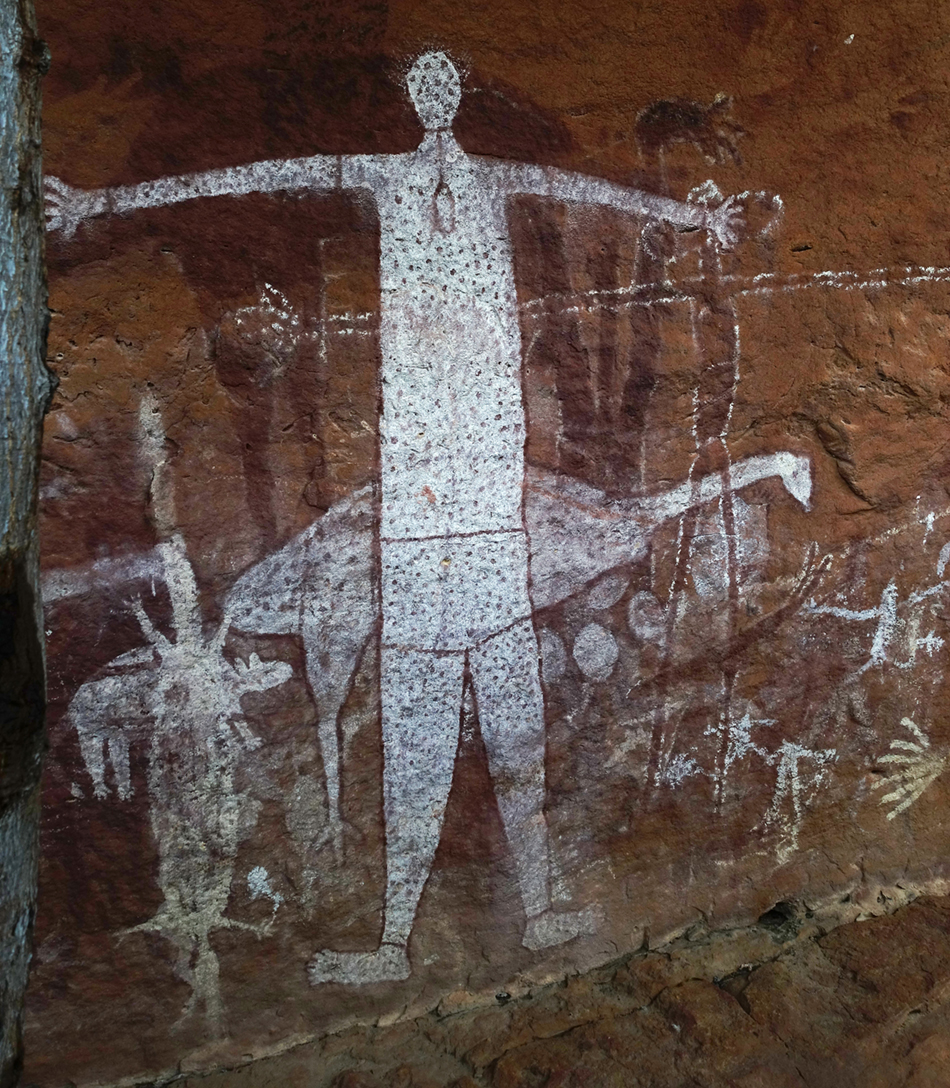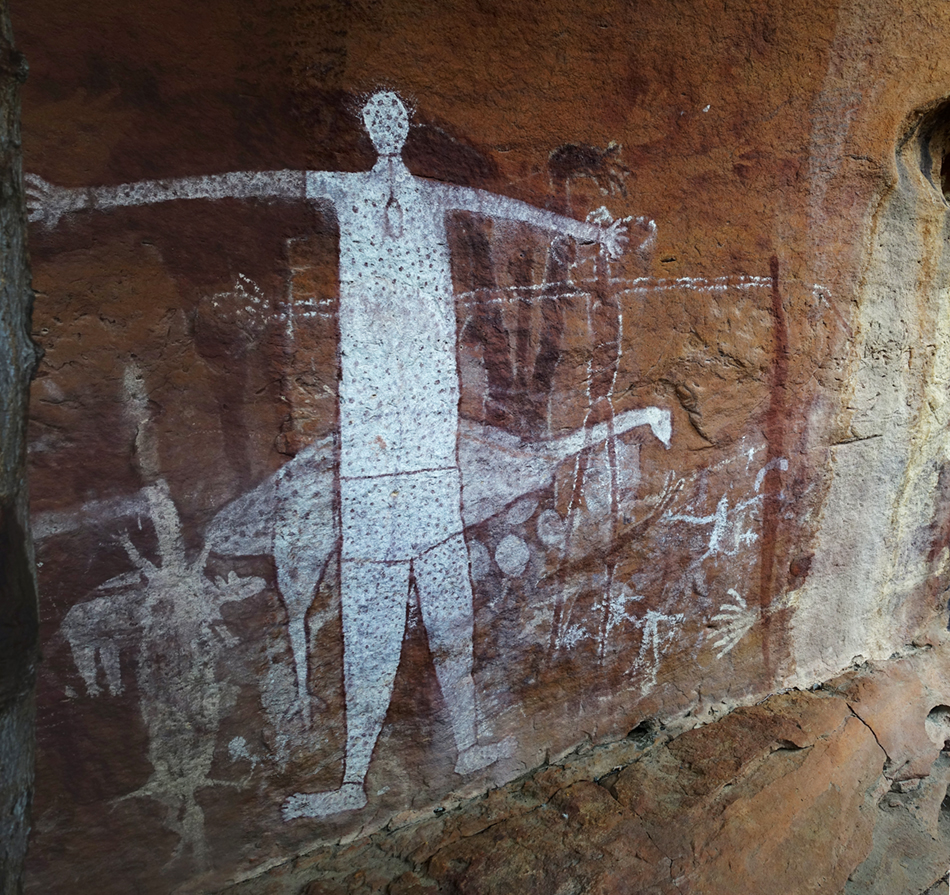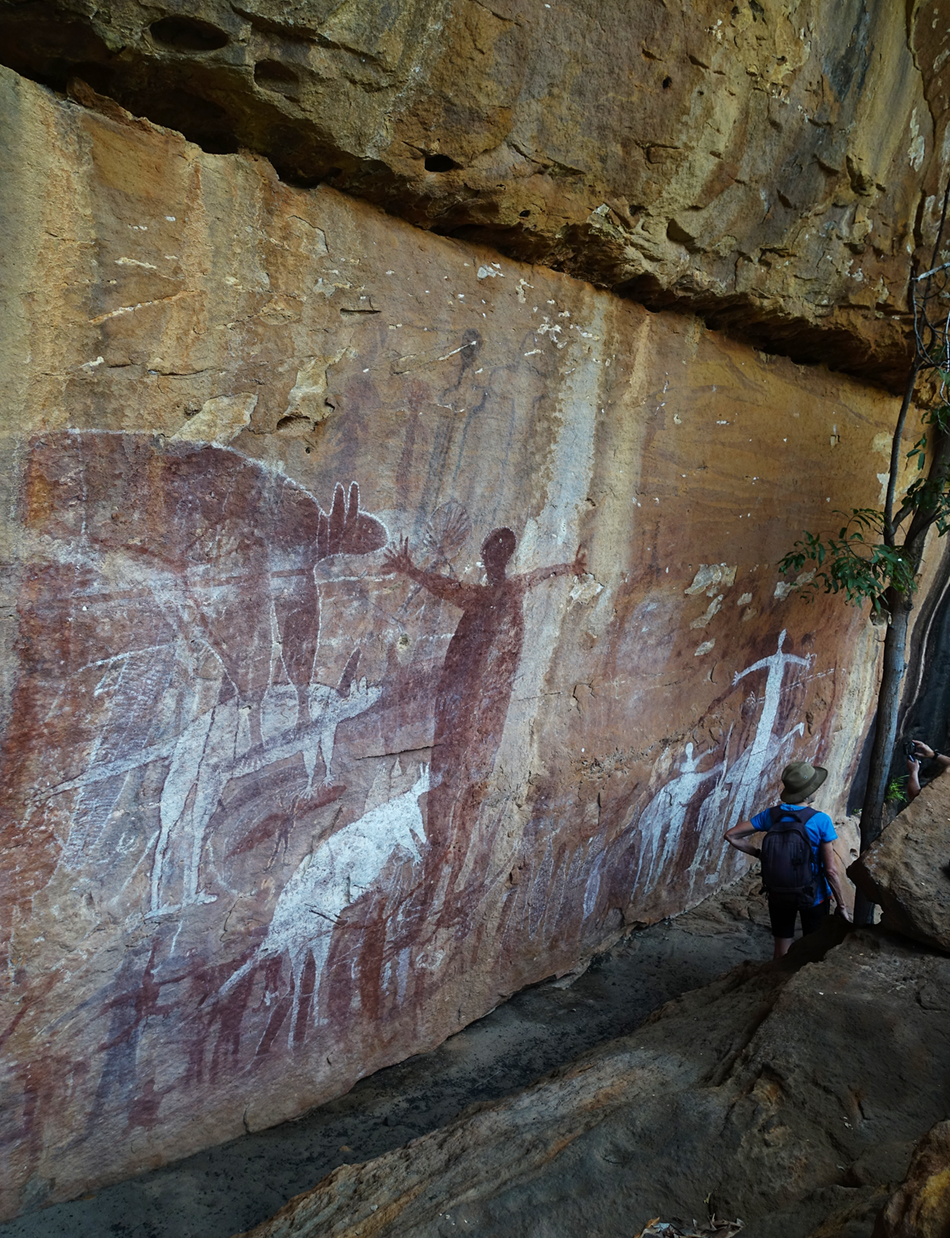Back to Don's Maps
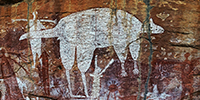 Back to Australian rock art and other Oz sites
Back to Australian rock art and other Oz sites Laura Rock Art

( Click on the image above to see the full size photo )
The Laura area has many rock art sites on the sandstone cliffs of the region.
This is a view of the gorge which contains the 'Magnificent Gallery'.
Photo: Don Hitchcock 2023
Location: Magnificent Gallery
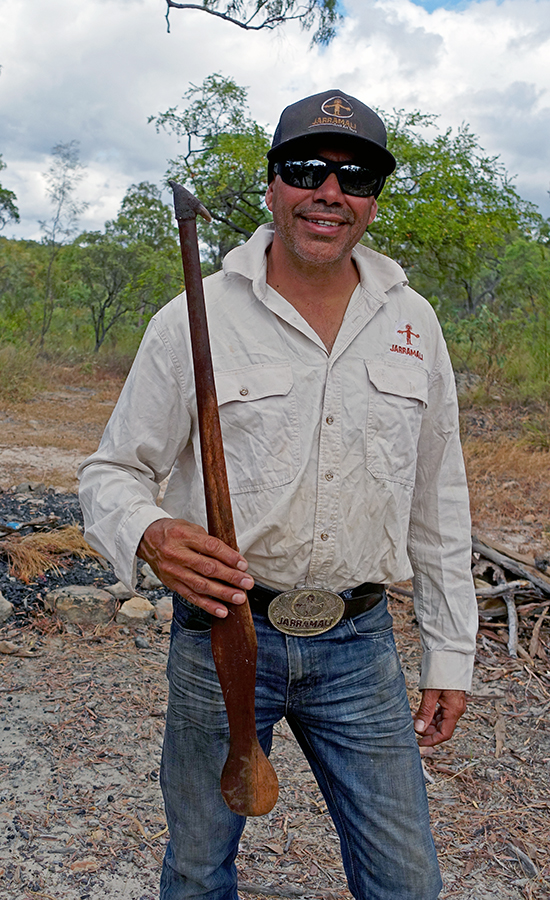
Johnny Murison is a traditional owner from the Kuku-yalanji people, and he takes his guests through the distinctive savannah grassland landscape to visit, amongst other galleries, the 20 000 year old rock art site known as 'Magnificent Gallery'.
It is an ancient gallery that is outstanding for its variety, quantity and quality, and is home to over 450 pieces of art. Johnny guides his guests through the gallery and interprets the art there, and brings the stories to life.
Here he is shown holding a superbly made woomera, used to launch spears to bring down game such as wallaroos.
Photo: Don Hitchcock 2023
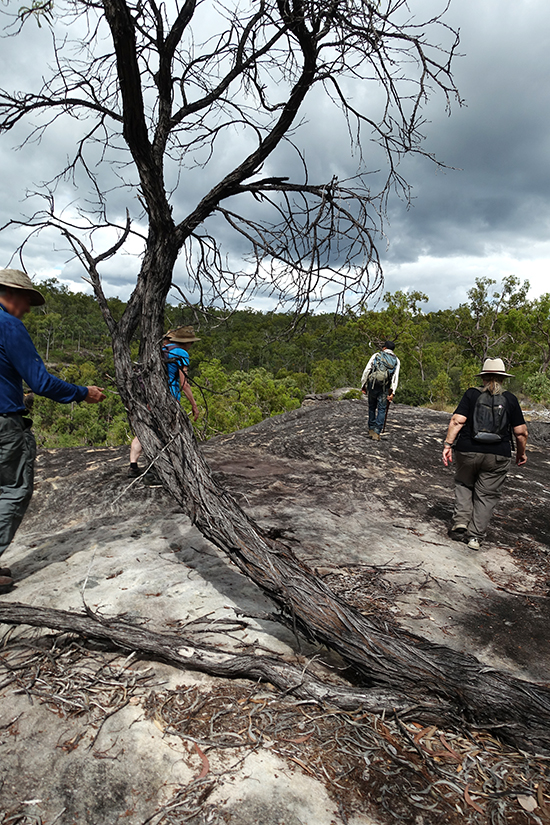
We set off for 'Magnificent Gallery' along the cliff top. After about 400 metres we took a path down to the gallery, which was about 100 metres from the entry point.
Photo: Don Hitchcock 2023
Green ant nest on the way to the gallery.
( As with all my images, click on the smaller image on the page to see the full size photo - Don )
Johnny says that nests like these were used to protect freshly killed game from predators if a large animal was speared, and the hunter had to go back to camp to get help to bring it in.
Photo: Don Hitchcock 2023
( Click on the image above to see the full size photo )
Magnificent Gallery, a complex and beautiful panel of art.
Photographers will appreciate the difficulties of doing the gallery justice when there are fallen rocks from the abri/rock face above which constrict the available viewing area.
Photo: Don Hitchcock 2023
Location: Magnificent Gallery
Johnny did a superb job of explaining the meaning and significance of the rock art.
Photo: Don Hitchcock 2023
Location: Magnificent Gallery
( Click on the image above to see the full size photo )
Panel 1
This panel shows an eel tailed catfish, Tandanus tandanus, with a range that extends from the Murray-Darling river system all the way to Cape York, and a northern long neck turtle, Chelodina rugosa, with a range restricted to the 'top end' of Australia.
To the right is a possum with a long tail, a male human painted over a barramundi with erect dorsal fin, and a lower frieze of human figures, possibly ancestral figures.
Photo: Don Hitchcock 2023
Location: Magnificent Gallery
( Click on the image above to see the full size photo )
Panel 2
The white marks above the paintings are where flakes of sandstone have broken off the surface.
( Click on the image above to see the full size photo )
Panel 2
This section of panel 2 shows an emu in white ochre on the left, with an earlier image of a barramundi beside it, and what may be an echidna below that.
A man with three fingers and a penis shown is painted in white ochre, with a large red ochre image outlined in white painted over it which is a symbol for a very important person with a headdress.
To the right is a later negative hand stencil in white on a very dark red background.
This hand appears to be painted on a very dark red echidna, outlined in white, but which is partially obscured by the barramundi above it.
Photo: Don Hitchcock 2023
Location: Magnificent Gallery
( Click on the image above to see the full size photo )
Panel 2
A man is shown with a prominent penis and a network of white lines on a dark background, which is the pattern of the bark of the Cooktown Ironwood, Erythrophleum chlorostachys, shown below, and denotes the 'country' he belongs to. His fingers are not shown. A negative hand print in white ochre overlaps his left leg.
Curiously, his head and right arm has been painted over to some extent, and a slightly curved, narrow object in the same colour descends from his right hand. This object may be the handle of a stone axe with ground edge, used to help extract honey from the Cooktown Ironwood.
Virtually all culturally modified trees in Eucalyptus tetrodonta woodland on Cape York Peninsula are Cooktown ironwoods. Most of these are 'sugar bag scars' where Aboriginal people have cut through the cambium into the heartwood of the tree to remove honey stored by native bees, known as 'sugar bag flies' in this area. Scars have been made using both stone axes (in pre-contact times) and steel axes (post-contact). These have particular significance to Aboriginal people as the tangible representation of past cultural practices. The large number of hollows found in Cooktown ironwoods at Kakadu National Park are also likely to be culturally modified trees.
Trees scarred during the extraction of wild honey are usually very distinctive with the key diagnostic criterion being the presence of an axe cut aperture as small as 5 cm in height and 2 cm in width. Before the arrival of Europeans these apertures were likely created using edge ground stone hatchets but these were probably rapidly replaced by steel axes and hatchets from the late 1800s onwards.
Photo: Don Hitchcock 2023
Location: Magnificent Gallery
References:
Taylor (2002),
Morrison, McNaughton, & Shiner (2010)
Additional text: Wikipedia
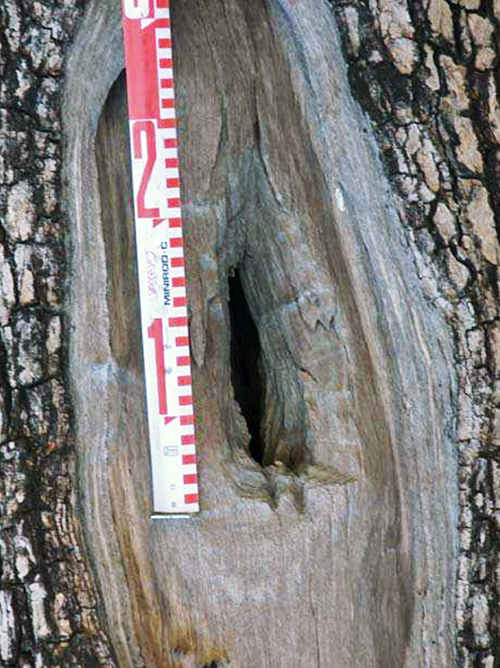
Sugarbag scar created with a steel hatchet.
This image shows the very distinctive bark pattern of this tree, used to show 'country' of the man in the previous rock art image.
Photo: Morrison, McNaughton, & Shiner (2010)
( Click on the image above to see the full size photo )
The sugarbag bee, Tetragonula carbonaria.
The bee is known to pollinate orchid species, such as Dendrobium lichenastrum, D. toressae, and D. speciosum. It has been identified as an insect that collects pollen from the cycad Cycas media. They are also known for their small body size, reduced wing venation, and highly developed social structure which is comparable to honey bees.
Tetragonula carbonaria forms honeycombs in their nests. The bee produces an edible honey; the whole nest is sometimes eaten by Indigenous Australians. The bees 'mummify' invasive small hive beetles, Aethina tumida, that enter the nest, by coating and immobilising the invaders in wax, resin, and mud or soil from the nest.
Photo: James Niland
Permission: Creative Commons Attribution 2.0 Generic license
Proximate source and text: Wikipedia
( Click on the image above to see the full size photo )
Panel 2
A red-brown owl is located below the 'Cooktown Ironwood' man. Based on range and preferred habitat it is likely a Barking Owl. The barking owl is common in North Queensland, and they inhabit drier woodland and forest type zones, often in habitats near creeks.
A brush turkey painted in white (in life they are predominantly black) is shown with its characteristic tail, overlain by the two red ochre legs of a male spirit figure.
It is normal for one image to be painted over others.
An earlier white ochre male figure with an elongated and engorged penis is shown below the brush turkey.
Photo: Don Hitchcock 2023
Location: Magnificent Gallery
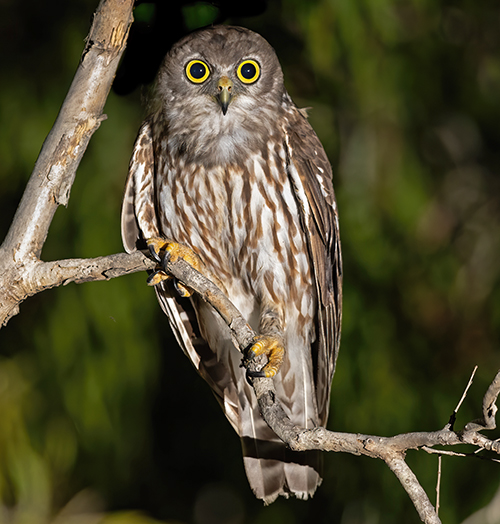
The barking owl, Ninox connivens, is a nocturnal bird species native to mainland Australia and parts of New Guinea and the Moluccas. They are a medium-sized brown owl and have a characteristic voice with calls ranging from a barking dog noise to an intense human-like howl.
Photo: JJ Harrison
Permission: Creative Commons Attribution-Share Alike 3.0 Unported license
Proximate source and text: Wikipedia
( Click on the image above to see the full size photo )
Panel 2
A male spirit figure in red ochre, with just the head thinly outlined in white, is shown with an elongated and greatly engorged penis, and six fingers, though only five toes are shown on the right leg.
Thin white vertical lines are shown at each shoulder, and below his neck.
Beside these figures is one shown in dark ochre in a sideways position, with white eyes and long arms with four fingers, with the body barely able to be made out. It may be that only the head and arms had been repainted at some time.
A white figure partially overlays the sideways figure, and it appears that the arms have been painted on the same side of the body, which is not the usual depiction. However the figure is somewhat indistinct, and this interpretation may not be correct.
To the right is a pale red ochre spirit woman, with a very long neck, and with arms extended above her head, and six fingers shown on the left hand, identifying her as a spirit figure.
Above her is an 'important person' symbol, consisting of a large headdress, sideways in this example, and including an empty closed figure, round at the outer end, and straight where it joins to the headdress itself.
The attachment to the headdress or empty closed figure, is outlined in white, except where it overlays a white earlier painting, at which point it has been painted in a pink ochre colour. It is possible that the headdress belongs to the pale red ochre spirit woman.
Photo: Don Hitchcock 2023
Location: Magnificent Gallery
( Click on the image above to see the full size photo )
Panel 2
To the right of the pale red ochre spirit woman with arms extended above her head is a well delineated 'important person' headdress. It appears to consist of two parts, the headdress itself, and a 'hollow' section below, possibly to secure it to the head and body of the wearer. The headdress has a red interior dotted with white, possibly indicating attached white bird feathers, and outlined in white.
An indistinct figure in brown ochre is depicted below it, and to the upper right is a female figure in brown ochre.
There are several linear figures below that, one of which may be a snake, in red-brown ochre, outlined in white.
Photo: Don Hitchcock 2023
Location: Magnificent Gallery
( Click on the image above to see the full size photo )
Panel 2
The most obvious animal shown here is a crocodile, shown vertically.
To the left of the crocodile are two macropods. The macropods in the Laura area are smaller species, such as the wallaroo and the swamp wallaby.
Photo: Don Hitchcock 2023
Location: Magnificent Gallery
( Click on the image above to see the full size photo - Don )
Panel 3
This is a very complex panel.
Photo: Don Hitchcock 2023
Location: Magnificent Gallery
( Click on the image above to see the full size photo )
Panel 3
At the upper left of the image is what appears to be the head of a very large macropod, in white ochre outlined with very dark red ochre.
Below that is an enigmatic anthropoid figure, also in white ochre and outlined in very dark red ochre.
Beside this figure is another possibly anthropoid figure in a bluish white ochre, with what appears to be a long-feathered headdress.
Photo: Don Hitchcock 2023
Location: Magnificent Gallery
( Click on the image above to see the full size photo )
Panel 3
On the left is a white ochre spirit figure, identifiable by the depiction of six fingers. It may be female.
Overlying this is the more recent figure of a man in red ochre, outlined in white, with a prominent penis. The delineation is very simple, with no decorations. The fingers are indistinct.
There is a curious shape in very white ochre behind the head of the red ochre man. It is earlier than the red ochre man, as can be seen by the leaking of white through the red ochre of the head and neck, yet this effect does not occur with the rest of the man. The shape may be a tool, but identification is difficult.
Photo: Don Hitchcock 2023
Location: Magnificent Gallery
( Click on the image above to see the full size photo )
Panel 3
The 'red ochre man' also overlies what appears to be a spirit figure, shown with a huge head and prominent eyes, with a median line down the face, as for the owl figure above. Six very long fingers are distinguishable on the left hand.
A white dotted indeterminate figure overlies the spirit figure, and underlies the 'red ochre man'.
Photo: Don Hitchcock 2023
Location: Magnificent Gallery
( Click on the image above to see the full size photo )
Panel 3
A barrumundi in dark red ochre underlies the spirit figure with large eyes.
Above the spirit figure is what may be a fairly modern negative hand print in white ochre. There are three dark vertical bands on the rock face which may be much earlier paintings, or may simply be water stains seeping from the sandstone.
Photo: Don Hitchcock 2023
Location: Magnificent Gallery
( Click on the image above to see the full size photo )
Panel 3
To the right of the large headed spirit figure is another man in red ochre, thinly outlined in white, with five fingers on each hand, and without a penis shown. This figure overlies a white macropod with a long tongue, the full form of which may be made out faintly under the red ochre man, with the tail quite visible on the other side.
To the right, and partly underlying the red ochre man, are two smaller simple white figures.
On the left of the red ochre man, and partially beneath his right hand, is a very dark and featureless anthropoid figure.
At the right hip of the red ochre man is a red ochre man with three fingers shown, not outlined.
A large bird that may be an eagle, in red ochre, outlined in white, and with a strong beak, is shown beside a white goanna, which is shown with four claws instead of five on the left back leg.
The large bird overlies what is probably a macropod, completed entirely in white ochre.
Photo: Don Hitchcock 2023
Location: Magnificent Gallery
( Click on the image above to see the full size photo )
Panel 3
Low down on the left, there is a dingo (with four equally long legs and the distinctive ears usually reserved for dingoes), a bird with a long neck and feathers on its rump, and a small human figure with four arms.
Photo: Don Hitchcock 2023
Location: Magnificent Gallery
( Click on the image above to see the full size photo )
Panel 3 Part 2
Photo: Don Hitchcock 2023
Location: Magnificent Gallery
( Click on the image above to see the full size photo )
Panel 3 Part 2
To the right of the spirit figure and the man in red ochre, thinly outlined in white, referred to above, is a fish in red ochre, a barramundi. This fish faces to the right, but there is ancient spalling along the black seepage line, which has removed part of the painting of the fish. The head of the barramundi apparently reappears to the right of the woman in white ochre.
The spalling has also affected the right breast of the woman in white ochre. Most of the spalling occurred before the painting of the white wallaroo, but there has been some spalling since that time on the lower part of the wallaroo's tail.
Painted over the barramundi is a woman painted in white ochre, with breasts spread in the normal way for such representations to show her sex, with arms spread wide, and showing five fingers on each hand. This figure is thinly outlined in red, and there are red bands in a cross shape around her neck and outlining her breasts. There is also a red band at her left shoulder, but spalling has removed it from the right shoulder.
Partly over this woman is an eel-tailed catfish in red, outlined in white, and with a white dorsal line added.
Beside and below it are two more recent negative hand prints in white over a red background.
An indistinct figure in dark red ochre, with two large white eyes, lies between the back legs of the wallaroo, and may be a spirit figure.
Photo: Don Hitchcock 2023
Location: Magnificent Gallery
( Click on the image above to see the full size photo )
Panel 3 Part 2
However the dominant figure in this panel is the giant white wallaroo, which is also an important figure on at least one other rock art site in the Laura area. It is a spirit figure however, since it is shown with six digits on its paws instead of the normal five. It is outlined thinly in red, and there are four thin vertical red bands on its body, another at the base of the tail, and another two on its neck and head. Spots have been painted on its body and thick tail, and its testicles have been shown.
Below the wallaroo is a female figure painted in white, with arms stretched above her head, and with her legs spread, as though jumping.
Photo: Don Hitchcock 2023
Location: Magnificent Gallery
( Click on the image above to see the full size photo )
Panel 3 Part 2
A similar, but smaller and much older wallaroo lies under the front legs of the white wallaroo. It has been completed in dark red ochre, with a thin white outline, and similar markings on its body to the large wallaroo, including thin vertical white lines on the body and many white dots. As with the large white wallaroo, the two eyes are shown, as though in a plan, while the ears are on the top of the head.
Two ancient spalling events along seepage lines have removed part of the painting.
A long legged bird shown with a simple oval shape for the body, in red ochre, lies over two white negative hand prints beside the 'jumping woman'.
To the right and below this bird is an ancient red ochre echidna stretched out horizontally, with two vertical white ochre bands on its body, and which has been damaged by spalling.
At the head of the echidna is an older painting, of what may be a parrot with wings spread, upside down, completed in white ochre, but other interpretations are very possible.
Photo: Don Hitchcock 2023
Location: Magnificent Gallery
( Click on the image above to see the full size photo )
Panel 3
The site is extremely well protected from the elements.
Photo: Don Hitchcock 2023
Location: Magnificent Gallery
( Click on the image above to see the full size photo )
Panel 3 Part 2
In this image we can see the white goanna figure outlined in red, with a curious double pattern on its hip and tail region.
Below and to the right of the goanna is what appears to be an anthropoid figure in yellowish white ochre, outlined in dark red.
Above and to the right of the goanna is what may be a woman painted in white ochre, but this is overlain by an indistinct painting in red ochre. To the right of this is a figure which is difficult to interpret, with what appear to be multiple arms and no defined head, though there appear to be two legs.
Beside this is what appears to be a long necked turtle, with a negative hand print in white over the body.
Two pale red very similar macropods have been painted beside the turtle, one of which is partly over the turtle. The macropods have been painted without contrasting outlines.
Below them is a white negative hand print, partially overlying a white ochre brush turkey with distinctive tail. To the right of this is what seems to be a bird with just the oval body shown, but with long legs.
To the left of the dark seepage lines is a woman in red, with her right side still discernible, including a long arm widespread, and a large breast, but only her right leg is still identifiable, because of the spalling and other damage from the seepage lines.
Underlying this woman is what appears to be a boomerang in red, outlined in white, and with many white spots on its surface.
A thin anthropoid figure also underlies the woman. It has been completed in solid white ochre, with a very long neck and arms, though short legs.
Photo: Don Hitchcock 2023
Location: Magnificent Gallery
( Click on the image above to see the full size photo )
Panel 4
Photo: Maria Hitchcock 2023
Location: Magnificent Gallery
( Click on the image above to see the full size photo )
Panel 4
It is difficult to determine if the large red ochre anthropoid figure is male or female. A large right breast outlined in white ochre is shown on the figure, but it may be from an underlying figure which is almost completely overpainted by an androgynous figure in red ochre also outlined in white ochre.
Photo: Maria Hitchcock 2023
Location: Magnificent Gallery
( Click on the image above to see the full size photo )
Panel 4
At lower left may be seen a small but thick bodied macropod, with the vertical lines dividing up the body, which seems to be a common method of depiction.
To the right of this is what appears to be a bandicoot, a small omnivorous marsupial in the area. Bandicoots are found throughout Australia, and can live in a wide variety of habitats.
Above and to the right of the macropod is a jumping human, completed in yellowish white ochre. This and the other, smaller anthropoid figures to the right, may be spirit or ancestor figures.
On the right is a large depiction of an echidna in red ochre. These would have been profitable to hunt (or rather gather!), since they are slow moving, spend their lives at ground level, and are easily caught. Negative handprints have been added to the body of the echidna.
To the right and below the echidna is a dingo in brown/red ochre, with the body divided by vertical lines.
Below and to the left of the echidna is a long legged animal bearing a distinct resemblance to a horse, completed in red ochre.
Gold was found in the nearby Palmer River area in 1872, and the town of Laura was founded as a staging camp on the road from Cooktown to the Palmer River goldfields. Thus the local people would have seen horses when the prospectors and store owners arrived in the area.
Violence against the local First Nations people began at around the same time.
In 1897 after legislation by the Queensland Government, local First Nations people were removed from the area and sent to reserves and missions across Queensland.
Photo: Maria Hitchcock 2023
Location: Magnificent Gallery
( Click on the image above to see the full size photo )
Panel 4
This is a close up photo of what I have (immediately above) indicated might be identified as a horse.
Close examination casts doubt on this interpretation, however. The depiction is not well enough drawn to come to a definite conclusion.
To the left is a well drawn marsupial, possibly a bandicoot, with a white negative hand print shown above it. Under the 'horse' is another long tailed marsupial.
Below this is what appears to be a fork-tailed catfish.
To the right of the catfish is what looks tantalisingly like a small but well painted head, mouth, eye, neck, and mane of another horse. It is outlined in black, and filled in with yellow ochre.
Photo: Don Hitchcock 2023
Location: Magnificent Gallery
Panel 4
This is a close up photo of what I suggest above may be the forequarters of a horse, including the forelegs and the ventral surface.
(or may not !! As my geology professor used to say, "to believe this, one must use the eye of faith")
Photo: Don Hitchcock 2023
Location: Magnificent Gallery
( Click on the image above to see the full size photo )
Panel 4
Photo: Don Hitchcock 2023
Location: Magnificent Gallery
( Click on the image above to see the full size photo )
Panel 4
Two large overlapping figures form an important image.
The underlying figure is of an important ancestral female spirit, wearing a tall headdress to emphasise her status.
The figure is painted in dark red ochre, outlined in white ochre, and is covered with white ochre dots.
Overlying this female figure is a male figure, shown with penis, decorated with a network of white lines on a red-brown background, the pattern of the bark of the Cooktown Ironwood, Erythrophleum chlorostachys. This is similar to the male figure shown in Panel 2 above, and denotes the 'country' he belongs to. Five fingers are shown on his right hand. The neck is long, but the head is not shown, or at least is reduced to two horizontal lines.
Underlying the male figure, but overlying the female one, are three eel tailed catfish, shown upside down.
On the right of the male figure is what appears to be a white ochre echidna, head down.
A dark red ochre catfish outlined in white ochre lies with its head towards the left of the image (the whiskers may be discerned), overlying the female spirit figure, but underlying the man with cooktown ironwood bark as a decoration. The catfish is not able to be identified further, since it is painted over so much, including a later white ochre negative handprint.
Photo: Don Hitchcock 2023
Location: Magnificent Gallery
( Click on the image above to see the full size photo )
These are anthropomorphic Kalkadoon motifs, northwest central Queensland, two of which have headdresses with a strong similarity to the figure above.
Photo: Ross et al. (2008)
Proximate Source: McDonald & Clayton (2016)
( Click on the image above to see the full size photo )
Panel 4
A female figure initially completed in red-brown ochre, has been almost completely covered in yellowish white ochre, partly as dots. She is shown upside down, with relatively small and pointed breasts.
Her left hand is shown with four fingers, and beneath it is a negative handprint in white ochre, from a hand which is unusually broad.
Photo: Don Hitchcock 2023
Location: Magnificent Gallery
( Click on the image above to see the full size photo )
Panel 4
Above the red-brown dingo at the base of the image is a curious figure.
It appears to be an oval body from which radiate eleven legs, each terminating in what appear to be three toed claws of birds.
Below and to the right of this figure is a 'falling' female figure in red brown ochre, with breasts shown, and wearing what may be a hair belt, completed in white ochre.
Below this is a smaller male figure with long penis shown, also wearing a hair belt, but also with an object in white ochre at his neck, which continues down his chest.
A small goanna with a long tail has been painted over the paws of the dingo, in white ochre.
Photo: Don Hitchcock 2023
Location: Magnificent Gallery
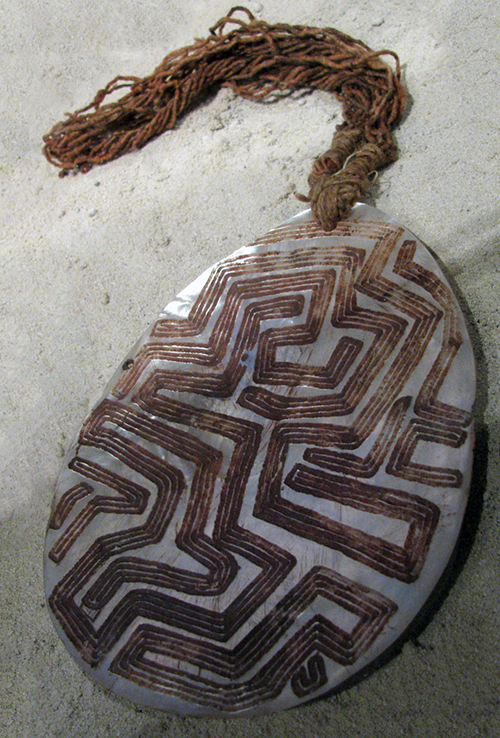
Pearl shell ornament with ochred engravings and hair string belt.
Hairstring is an important textile traditionally made by Australian First Nations people.
People, particularly women, would cut their hair regularly using quartz or flint knives. This hair is never wasted. It can be spun into long threads of yarn on a spindle rolled on the thigh and then plaited to about the thickness of 8 ply wool.
Purposes for the string are manifold. These include making the head ring for resting the coolamon, headbands to keep the hair off the face, spear-making (securing the head to the shaft), and even balls for ball games.
A general-purpose belt is made of the string, from which things could be hung, such as small game like goannas in order to free the hands on long walks and hunts.
The string could be dyed various shades using dyes such as ochre. Some string was only worn for ceremony, such as skirts worn by the women.
Photo: Don Hitchcock 2010
Source: Display, Sydney Museum.
Catalog: Acquired 1925, artist unknown, Admiralty Gulf, Western Australia.
Additional text: Modified from Wikipedia
Neck-ornament made of wool cord, multiple strands tied together.
Height: 860 mm, with 160 mm, depth 35 mm.
Catalog: Wool, Australian First Nations People, produced before 1898, acquired at Sherlock River by Dr Emile Clement, Oc1898,1011.9
Photo: © Trustees of the British Museum, CC BY-NC-SA 4.0
Permission: Creative Commons Attribution-NonCommercial-ShareAlike 4.0 International (CC BY-NC-SA 4.0) license.
Source: Original, British Museum
Text: Card at the British Museum, http://www.britishmuseum.org/, © Trustees of the British Museum, CC BY-NC-SA 4.0
( Click on the image above to see the full size photo )
Panel 4b
This section of panel 4 is, in general, not as well defined as many other panels.
Photo: Maria Hitchcock 2023
Location: Magnificent Gallery
( Click on the image above to see the full size photo )
Panel 4b
At the top of the image is a figure in dark red ochre, which appears to be the head, front legs and shoulders of a echidna.
Below this is an enigmatic broad oval animal. It appears to have a bifurcated 'tail', with two protrusions towards the back of the body. It appears too wide for a fork-tailed catfish, and the bifurcation is too small.
Above it is an anthropomorphic figure, probably male, in dark red ochre with arms spread out.
A bird, possibly an emu, is shown at the foot of the wall, and is painted in red ochre outlined in white, and with three vertical lines on the body.
On each side of the bird are a pair of boomerangs, one of which is decorated with transverse bands in yellowish white ochre.
Above this boomerang is an anthropomorphic figure, probably male, in white ochre without an outline, with arms and legs spread out.
( I suspect that this group of paintings may well have been done by children - Don )
Photo: Don Hitchcock 2023
Location: Magnificent Gallery
( Click on the image above to see the full size photo )
Panel 5
This relatively small panel is defined by two vertical black seepage areas.
Photo: Don Hitchcock 2023
Location: Magnificent Gallery
( Click on the image above to see the full size photo without the added red rectangle )
Panel 5
Within the red rectangle is a white ochre figure, outlined in very dark brown.
This very enigmatic figure has been decorated with semi-vertical sinuous lines in black. It appears to consist of a large, U shaped object, with the ends of the U quite pointed, the upper arm being twice as wide as the lower.
It may be that this apparent shape is an illusion, and the object was originally a large oval, which has been overpainted by the broad oval animal with an apparent bifurcated 'tail' referred to above.
If this is the true interpretation, it may originally have represented either a shield, or a coolamon, a multi-purpose shallow vessel or dish traditionally used by Australian First Nations people to carry water, fruits, nuts, and other types of bush tucker.
Towards the bottom left of the image, there are several fish-like objects, created as shapes made up only of white ochre dots without defining outlines.
To the right of these is a white ochre anthropomorphic figure, which might be either male or female. No penis is shown, but there may originally have been breasts. This has been painted over a dark red object which may represent a yam.
Photo: Don Hitchcock 2023
Location: Magnificent Gallery
Yams
( The following information about yams comes from a variety of sources, but principally Wikipedia - Don )
It is important to realise that edible yams in the Dioscorea family have been cultivated for tens of thousands of years across many parts of the tropical world, including Africa, Indonesia, New Guinea, and Australia.
In particular, Dioscorea alata, also known as purple yam, ube, or greater yam, among many other names, is an especially valued species of yam. The tubers are usually a vivid violet-purple to bright lavender in colour (hence the common name), but some range in colour from cream to plain white.
It is one of the most important staple crops in Austronesian cultures, and is one of various species of yams that were domesticated and cultivated independently within Island Southeast Asia and New Guinea for their starchy tubers.
Purple yam is believed to be a true cultigen, only known from its cultivated forms. The vast majority of cultivars are sterile, which restricts its introduction into islands purely by human agency, making them a good indicator of human movement. Some authors have proposed, without evidence, an origin in Mainland Southeast Asia, but it shows the greatest phenotypic variability in the Philippines and New Guinea.
( This variability is an argument for its beginnings in the Philippines and New Guinea, and indeed some sources do in fact say that its origins are in Southeast Asia - Don )
Dioscorea alata tuber, Marché du Chaudron, Saint-Denis de La Réunion
This is the most common type of yam, the purple yam.
Photo: Remi Tournebize
Permission: Creative Commons Attribution-Share Alike 3.0 Unported license.
Yams vary in size from that of a small potato to a record 130 pounds (as of 1999). There are over 600 varieties of yams and 95% of these crops are grown in Africa.
They are very easy to propagate. If a tuber is cut up into pieces and placed in moist soil, they will sprout within one to three months.
Based on archaeological evidence of early farming plots and plant remains in the Kuk Swamp site, authors have suggested that it was first domesticated in the highlands of New Guinea from around 10 000 BP and spread into Island Southeast Asia via the Lapita culture circa 4 000 BP, along with Dioscorea nummulariaand Dioscorea bulbifera. In turn, Dioscorea esculenta is believed to have been introduced by the Lapita culture into New Guinea.
However, much older remains identified as being probably Dioscorea alata have also been recovered from the Niah Caves of Borneo (Late Pleistocene, pre
40 000 BP) and the Ille Cave of Palawan (circa 11 000 BP), along with remains of the toxic ubi gadong, Dioscorea hispida, which requires processing before it can be edible. Although it doesn't prove cultivation, it does show that humans already had the knowledge to exploit starchy plants and that Dioscorea alata were native to Island Southeast Asia. Furthermore, it opens the question on whether Dioscorea alatais a true original species or whether it has been cultivated and selected for desirable traits for a very long time.
( Note, however, that despite the information above, and the desirability of the species as a food source, I have found no evidence whatsoever that Australian First Nations people used or cultivated Dioscorea alata - Don )
The centre of origin of purple yam is unknown, but archaeological evidence suggests that it was exploited in Island Southeast Asia and New Guinea before the Austronesian expansion. Purple yam is believed to be a true cultigen, only known from its cultivated forms. The vast majority of cultivars are sterile, which restricts its introduction into islands purely by human agency, making them a good indicator of human movement. Some authors have proposed, without evidence, an origin in Mainland Southeast Asia, but it shows the greatest phenotypic variability in the Philippines and New Guinea.
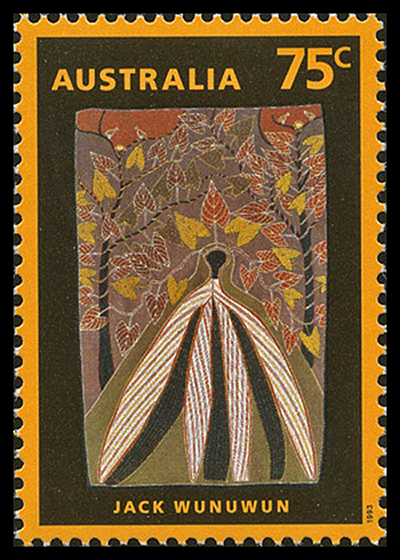
Yam Stamp.
One of four stamps featuring Aboriginal traditional artists.
The artist Jack Wunuwun's name for this artwork is 'Yam'.
Plant: Dioscorea transversa
'Long Yam'
Slender climber, annual above-ground parts from perennial tuber which is up to 50 cm long and 5 cm diameter. Leaves heart-shaped.
The tuber is much sought after by Aboriginal people, eaten raw or roasted, and tastes similar to sweet-potato.
Date of issue: 4 February 1993
Artist: Jack Wunuwun
Designer: C. Atkinson
Printer: Prinset Cambec
Photo and text: © An Australian Government Initiative, Australian National Herbarium, Australian National Botanic Gardens.
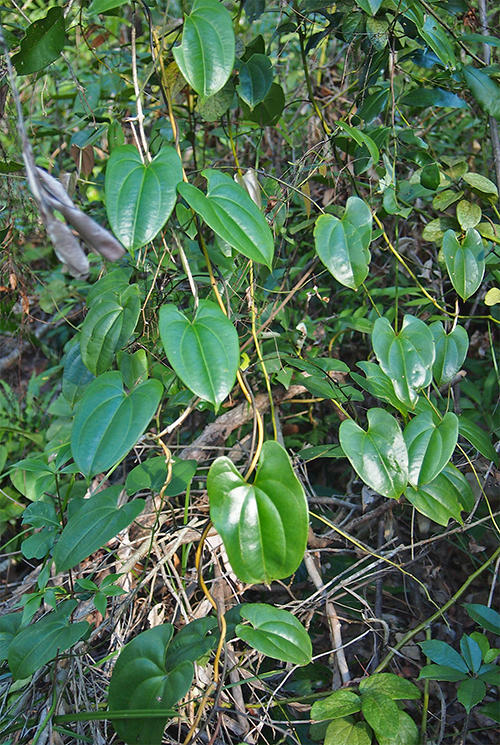
Yams have been an important food source for First Nations people in northern Australia for thousands of years. The yam species most commonly used include the wild yam, or pencil yam, Dioscorea transversa, which is a vine of eastern and northern Australia, the leaves of which are shown at left.
The leaves are heart-shaped, shiny, with 5-7 prominent veins. The seed pods are rounded, green or pink before drying to a straw brown papery texture. The edible tubers are typically slender and long. There are two forms: an eastern rainforest and wet sclerophyll form which doesn't have bulbils, and a northern form which occurs in open forests and has small bulbils and large inground tubers.
The tubers were a staple food of Australian First Nations people and are eaten after cooking, usually in ground ovens. The 1889 book 'The Useful Native Plants of Australia records that common names included 'Long yam', Australian First Nations people from Central Queensland referred to it as 'Kowar' and that 'The small young tubers are eaten without any preparation.'
Photo: Mark Marathon
Camera location: Weerriba, north of Rockhampton.
Permission: Creative Commons Attribution-Share Alike 4.0 International license.
Text: Wikipedia
( Click on the image above to see the full size photo )
Panel 5
On the left is a male figure in yellowish white ochre, without an outline. The figure has a wide right arm, but the left arm is not shown except for a stump. The figure has an engorged, long penis. It overlies another more delicately modelled figure.
An earlier figure near its feet has been painted in white ochre, and outlined in dark brown. It has a very round face, with brown spikes of hair on the top of its head, and the left arm has just three fingers. The arms and legs are narrow. It may be a spirit figure.
Beside this is the body and legs of a bird, upside down.
Above this is a very carefully outlined geometric figure, with parallel sides and a semicircular end, painted in bluish white ochre, and outlined in dark red. It may represent a shield or a coolamon.
There is a projection on the semicircular section.
Painted on top of this, in dark red ochre, is a female quinkan figure with very thin arms, and long misshapen breasts. See the outlined figure below.
Above and to the right is a figure painted in white ochre, with a headdress similar to some quinkan figures. See the outlined figure below.
Photo: Don Hitchcock 2023
Location: Magnificent Gallery
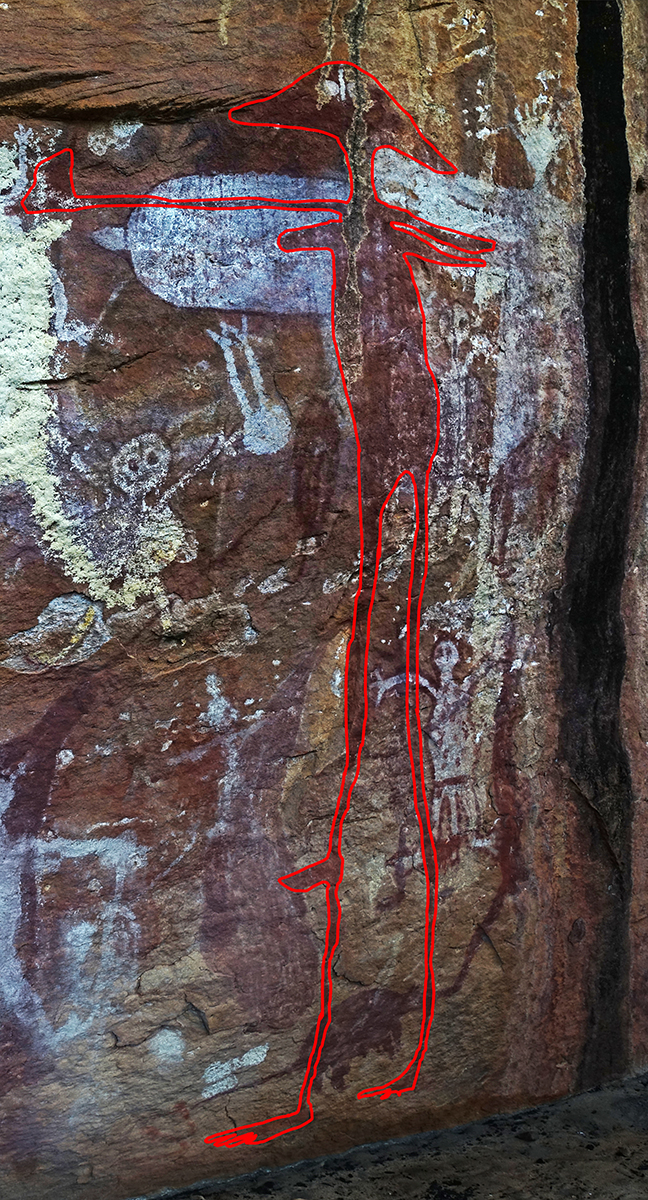
( Click on the image at left to see the full size photo )
( Click here to see the image without the red outline )
Panel 5
Outlined in dark red ochre is a female Quinkan figure with long, very thin arms and legs, and long misshapen breasts.
Quinkan figures often have large ears, leading to the false impression in less detailed depictions, as here, of a mushroom shaped head.
Photo: Don Hitchcock 2023
Location: Magnificent Gallery
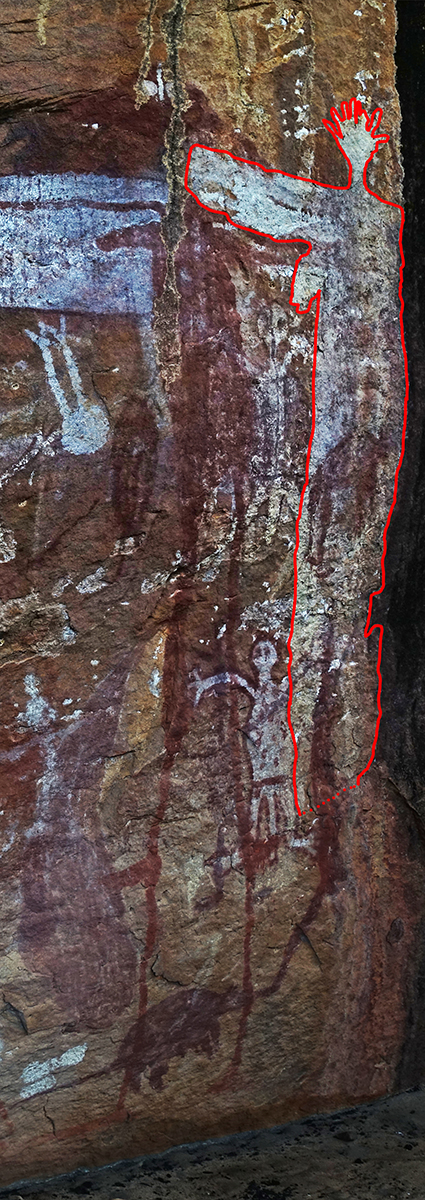
( Click on the image at left to see the full size photo )
( Click here to see the image without the red outline )
Panel 5
A long white female figure has been painted perhaps three times in different shades of white. The lower section is difficult to outline, due to overpainting with other images, and the effects of time.
The tall headdress is associated with some Quinkan figures.
Photo: Don Hitchcock 2023
Location: Magnificent Gallery
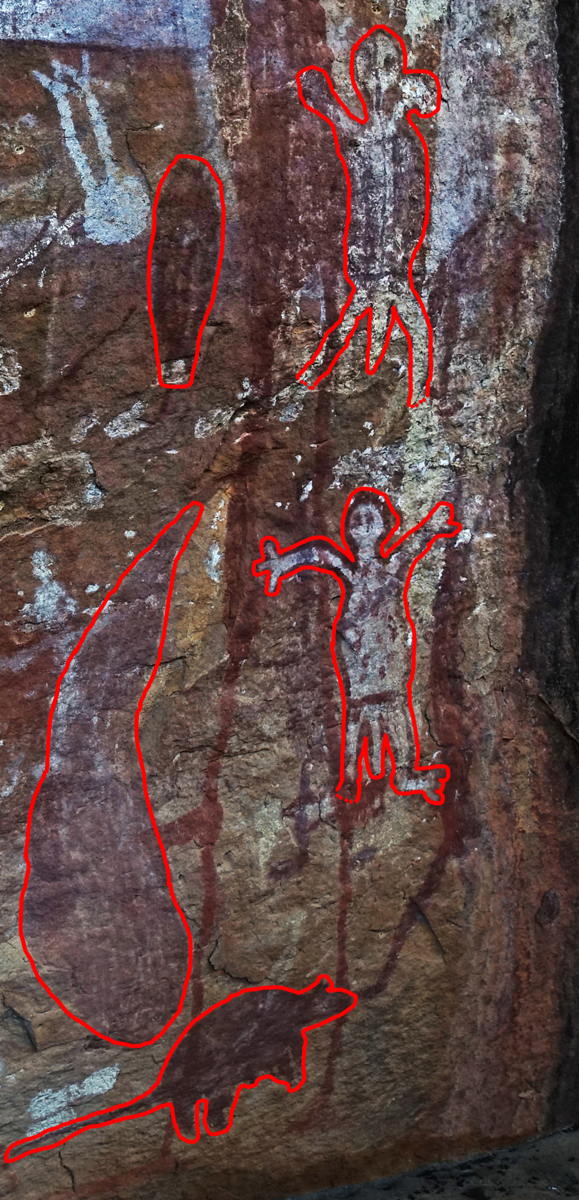
( Click on the image at left to see the full size photo )
( Click here to see the image without the red outline )
Panel 5
On the right are two male figures with prominent penises, in white ochre outlined in dark red/brown. The lower figure has a three toed left foot, though the right foot is indistinct, and it is possible that the penis on this figure originally was longer, with the glans below the level of the feet, but this has perhaps been obscured by a later painting in dark red ochre.
On the left top is an indistinct animal figure, with a large yam below that, and possibly a possum at the foot of the image.
Photo: Don Hitchcock 2023
Location: Magnificent Gallery
Panel 6
This complex panel shows at the top a large red ochre filled wallaroo outlined in white. Vertical lines have been drawn over the red filling at the neck. The wallaroo was probably originally complete, but the rear section appears to have been washed off by water seepage down the rock.
Above the red wallaroo are what seem to be two ancient but simple outlines of anthropomorphic figures in black, as well as two smaller figures in a solid red ochre infill with apparently large heads or headdresses, as well as a positive hand print.
What may be a catfish underlies the red wallaroo. The possible catfish consists of a white outline and a midline, and with dozens of white lines running crossways from the midline to the two outlines.
Below this figure are two smaller white wallaroos, painted at a previous time from the large red wallaroo, to judge from the overlap on the first white wallaroo.
Between these two white wallaroos is a dark coloured anthropomorphic figure, outlined in white. The apparent 'wings' are probably part of a different painting, and above the figure are two boomerang paintings in very dark red outlined in white ochre and decorated with spots.
Below the feet of the upper white wallaroo is and anthropomorphic figure with very long limbs, apparently jumping or dancing, and with what may be a tall conical hat on its head.
The lower white wallaroo has been painted over a yellowish white echidna, of which the front paws and head can be seen.
A large red ochre human with seven fingers on the right hand and six on the left stands with arms widespread to the right of the panel. It has a long penis shown, and the head has been partially outlined in white.
Behind this figure is a spirit figure in black, outlined in white, with a large fan-shaped headdress, and with lines radiating from the head.
To the right of the figure, at the level of the lower legs, is a figure shown upside down, with a long thick penis with the glans shown clearly.
At the lower right are images of two yams, decorated with white spots.
Photo: Don Hitchcock 2023
Location: Magnificent Gallery
Panel 7
This panel is remarkable for the six nearly identical yams, completed in dark red ochre, outlined in white, and decorated with white spots.
An enigmatic white animal has been added to the group of yams.
A rotund red ochre bird with no obvious head, and outlined in white, is placed on the right hand side of the group of yams.
The red head of a macropod with small ears has been partially covered by one of the yams.
To the right of the yams is a man in white with a large penis and testicles, overpainted by a white emu outlined in red ochre.
What appears to be a Quinkan figure with large ears has been added over the emu and the man in white. This figure has been painted in dark red ochre, one hand has four fingers, and the eyes are very prominent. White horizontal dotted lines have been used as decoration.
To the right of the Quinkan figure is a macropod, possibly a wallaroo, in white, overpainted with what might be a long necked turtle.
Photo: Don Hitchcock 2023
Location: Magnificent Gallery
Panel 8
The dominant part of this panel is the white male spirit figure, shown with a reddish brown neck cord, from which hangs another cord and an oval object.
On the right arm are two thin reddish brown bands, at the biceps and wrist. The corresponding bands on the left arm are not as obvious, although they seem to have once been there, though now faded. Similar bands are shown at each ankle. Five fingers are shown on each hand, but six toes are visible on the right foot.
The figure is notable for the 'briefs' with which the figure is clothed, and no genitalia are shown.
The figure is outlined in reddish brown, infilled in white, decorated with dark spots.
Under the main spirit figure is an emu with eggs, completed in the same style.
Also under the spirit figure is a Quinkan figure, with outsize right hand/fingers, and very large ears, as is common. The Quinkan figure is quite elongated, and is completed in red ochre, outlined in white. No genitalia or feet are shown, and the head is barely indicated.
Behind both is what appears to be a reddish brown wallaroo, minimally outlined in white on the legs at least.
Earlier than all of these in time is what may be an upside down spirit figure, shown with a very long phallus and what appears to be a distorted foot, though other interpretations are possible.
At the lower right of the lower image may be seen various spirit figures, and a six fingered hand. The rest of this figure has been removed by water seepage down the rock face.
Photo: Don Hitchcock 2023
Location: Magnificent Gallery
Panels 6, 7, and 8 complete the Magnificent Gallery.
Photo: Don Hitchcock 2023
Location: Magnificent Gallery
References
- Cole N., Watchman A. , 2005: AMS dating of rock art in the Laura Region, Cape York Peninsula, Australia - Protocols and results of recent research, Antiquity, 79(305), DOI:10.1017/S0003598X00114590.
- Fillios M., Taçon P. , 2016: Who let the dogs in? A review of the recent genetic evidence for the introduction of the dingo to Australia and implications for the movement of people, Journal of Archaeological Science: Reports, Elsevier Ltd.
- McDonald J., Clayton L. , 2016: Rock Art Thematic Study, Report to the Department of the Environment and the Australian Heritage Council, Centre for Rock Art Research and Management, University of WA.
- Morrison M., McNaughton D., Shiner J. , 2010: Mission-Based Indigenous Production at the Weipa Presbyterian Mission, Western Cape York Peninsula (1932–66), Int J Histor Archaeol, DOI 10.1007/s10761-009-0096-8, Springer.
- Ross, J. et al. , 2008: More than Motifs: the archaeological analysis of rock art in arid regions of the southern hemisphere, Chungara, pp.273–294.
- Taylor R., 2002: "Ironwood Erythrophleum chlorostachys in the Northern Territory: aspects of its ecology in relation to timber harvesting", Report to Agriculture, Fisheries and Forestry, Australia.
Back to Don's Maps
 Back to Archaeological Sites
Back to Archaeological Sites
